

How Much Does It Cost To Fill a Superyacht With Fuel?
Owning a yacht is a dream for many. However, when it comes to the super-wealthy, yachts tend to increase greatly in size from fairly modest vessels to huge and luxurious superyachts with hefty price tags and running costs.
The price of filling a superyacht with fuel depends on various factors, such as the vessel’s size and fuel tank capacity. An average 70-meter superyacht utilizing 500 liters of fuel an hour may have fuel costs around $400,000 a year, though these costs will increase significantly for larger vessels.
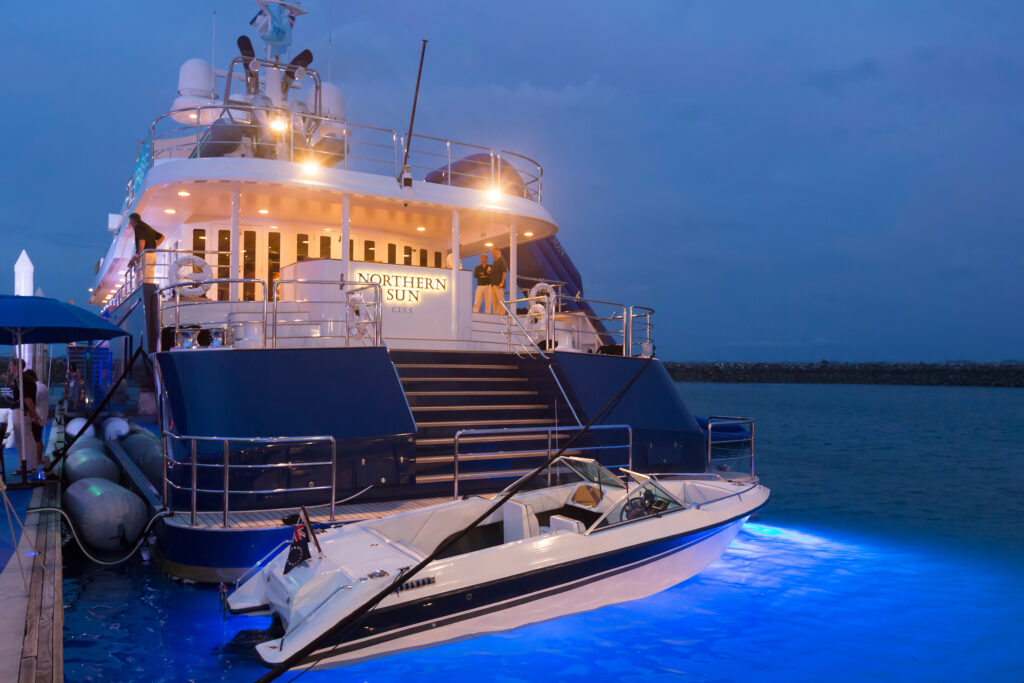
Fuel is a key factor that can’t be overlooked when it comes to the operating costs of a superyacht, though it is certainly not the only cost associated with running these impressive luxury vessels.
Average fuel costs to fill a superyacht
The amount of fuel required to fill a superyacht will vary depending on the specific yacht. Obviously, the larger a yacht is, in general the more fuel it will require, though onboard services will also make use of fuel so the degree of luxury and services on a superyacht will affect fuel usage too.
As a working figure, the average 70-meter yacht will use around 500 liters of fuel an hour and this is just to keep the engines running without actually moving the boat. If such a vessel were to achieve cruising speeds of around 18 knots, the fuel cost per hour would be roughly around $2500.
This would equate to around $31,000 for a 12-hour cruising period (such as overnight cruising). However, fuel costs would be much greater for larger vessels. Annual fuel costs for a 71-meter yacht using 500 liters an hour could come in at around $400,000.
The longest superyacht in the world is the Azzam , which was constructed by the German shipbuilding company Lürssen. The Azzam has an overall length of 180.65 meters and a fuel tank capacity of 1 million liters.
This amount of fuel is equivalent to filling up almost six Boeing 747 airplanes and will contribute significantly to the running costs of this majestic vessel.
Other running costs to consider
Fuel is one of the primary costs that potential superyacht owners may think about since the vessel won’t run without it and it regularly needs to be replaced. However, many other costs also need to be considered which are unavoidable when operating a superyacht.
A large part of monthly costs is crew salaries, both for the crew on the vessel as well as the onshore crew. While salaries will vary from one position to the next, a captain’s salary alone can range from $70,000 to $180,000 a year depending on the size of the vessel, not to mention the additional costs associated with the crew such as food and living expenses.
Regular general maintenance will also be required, as well as administrative expenses such as management and insurance costs that need to be considered as well. Further costs include berthing costs, with different ports charging different amounts per night depending on their popularity and the vessel’s size, as well as expenses related to security.
These costs will obviously vary depending on factors such as how large the superyacht is and how many crew members it has. While one superyacht may utilize 10 crew members, another may utilize 50 crew members.
In general superyacht owners should budget to pay around 10% of the vessel’s purchase price in annual running costs each year. For a superyacht such as the Azzam which cost around $600 million, that equates to around $60 million a year in operating and maintenance costs to keep the superyacht in tip-top condition.
A luxury price tag for a luxury pleasure
There is no denying that superyachts are luxurious purchases but their exceptionally high purchase costs and operating expenses limit them to the domain of ultra-high net worth individuals. However, many owners won’t spend more than a few weeks in total onboard their vessel each year.
With such high operating costs, it makes sense that a lot of superyachts can be chartered, with prices of around $150,000 a week fairly common, though some command much more than that, even over $1.3 million a week. Chartering a superyacht allows much of its operating costs to be covered, while still allowing the owner to enjoy their vessel at various periods throughout the year.
- Privacy Policy
© 2021 Black Sands Media - All Rights Reserved
- Food & Drink
- Leisure & Recreation
- Art & Collectibles
CALL US TODAY Fort Lauderdale: 954-467-9010 Punta Gorda: 941-505-2400
Fort lauderdale: 954-467-9010 punta gorda: 941-505-2400.
Our Guide to Yacht Fuel Capacity and Consumption
by Marine Diesel Specialists | Jul 25, 2023 | Blog , MAN Engines , Yacht Engines , Yacht Upkeep | 0 comments
Fuel consumption for yachts can vary based on factors such as the yacht’s size, weight, design, engine type, cruising speed, and the duration of the journey. Smaller pleasure yachts generally tend to be more fuel-efficient than larger luxury yachts, which may consume more fuel at cruising speed. Efficient navigation planning and optimizing cruising speed can play a crucial role in managing fuel consumption effectively. Regular maintenance and adherence to best practices can also contribute to improved fuel efficiency, ensuring that yacht owners can enjoy their voyages with minimized environmental impact and reduced operational costs. If you wish to understand more about yacht fuel capacity and use, then this article from Marine Diesel Specialists , experts in all things professional marine services , is a great place to start your journey toward understanding.
How Much Fuel Does a Yacht Hold?
Fueling a yacht is a critical aspect of ensuring smooth sailing and an enjoyable journey. The amount of fuel a typical yacht can hold in its tank varies greatly depending on the vessel’s size and purpose. Generally, yachts are designed with fuel tank capacities tailored to their intended use, whether it be coastal cruising or transoceanic voyages.
For smaller pleasure yachts, you can expect to find fuel tank capacities ranging from 200 to 1,000 gallons. These yachts are typically designed for shorter trips, day cruising, or weekend getaways, and their fuel capacities reflect those requirements. On the other hand, larger and more luxurious yachts, like superyachts and mega yachts, boast significantly larger fuel tank capacities. Average yacht fuel capacity can vary anywhere from 10,000 to 50,000 gallons of fuel, allowing them to undertake extended journeys across vast distances with ease. It’s essential for yacht owners and operators to understand their yacht’s fuel tank size and plan their trips accordingly to ensure they have enough fuel to reach their destinations safely.
Remember, knowledge about fuel for yachts and yacht fuel tank sizes is vital to maximizing your sailing experience and minimizing the risk of running out of fuel during your adventures on the open waters. For more in-depth information on this topic, we recommend checking out reputable websites of yacht manufacturers that provide comprehensive data on yacht specifications and fuel capacities. There are many factors that can make the capacity of any specific yacht’s fuel canister better or worse for the owner; one such factor is the amount of resources that are used over the course of a trip out on the water.
How Much Fuel Does a Yacht Use?
Average yacht fuel consumption can vary significantly depending on several factors, including the yacht’s size, weight, and duration of your journey out on the water. It’s crucial to consider the yacht fuel capacity of the vessel and its efficiency to better understand its consumption patterns. Fuel capacity is the total amount of fuel a yacht can hold in its tanks, as we mentioned in our previous discussion on yacht fuel tank sizes. Fuel-efficient yachts are designed to minimize fuel consumption while maximizing performance, providing a more eco-friendly and cost-effective sailing experience.
On average, smaller pleasure yachts with fuel capacities ranging from 200 to 1,000 gallons tend to be more fuel-efficient. They often feature modern technologies and hull designs optimized for reduced resistance and better fuel economy. As a rough estimate, these yachts can consume around 20 to 50 gallons of fuel per hour at cruising speed. Larger luxury yachts, such as superyachts and mega yachts with fuel capacities of 10,000 to 50,000 gallons, may have higher fuel consumption rates, averaging around 100 to 500 gallons per hour at cruising speed.
If you are looking to get the most out of your yacht, then you cannot go wrong with marine diesel services and products for marine vessels that are designed to make every trip out on the water smoother and better than the one before. Luckily our expert marine rebuild specialists are able to provide all of the assistance you could ever need.
The Marine Diesel Experts in Fort Lauderdale Are Here to Help
Welcome to Marine Diesel Specialists, your ultimate destination for comprehensive boat engine care and top-quality products. As an authorized distributor, we take immense pride in offering exceptional MAN diesel marine engines renowned for their unrivaled reliability and outstanding performance. Our esteemed Gulf Coast Diesel Service branch operates with marine rebuild specialists in Fort Lauderdale and Punta Gorda, all dedicated to delivering unparalleled customer satisfaction.
Whether you seek expert guidance on engine selection, reliable repairs, or meticulous maintenance, our seasoned professionals are eager to provide you with comprehensive insights and personalized assistance. We’re committed to ensuring your boating experience is smooth and worry-free. To deepen your knowledge of marine engines, we encourage you to explore our vast collection of informative articles on our marine engine care blog which covers topics ranging from yacht fuel capacity and much more. Feel free to contact our marine industry professionals today to discover the full spectrum of our offerings and experience our unwavering commitment to excellence.
Related Readings
- Finding the Best Marine Diesel Engine for You
- Benefits of MAN Marine Engines
Our Marine Diesel Specialists offer a variety of products and services to provide marine diesel solutions in Fort Lauderdale and Punta Gorda. Our authorized MAN Engine dealers can offer expert maintenance, repair, and survey services, as well as complete engine, transmission, and generator overhauls. If you are seeking top-quality marine diesel solutions, products, or services, don’t wait to contact our Marine Diesel Specialists and Gulf Coast Diesel Service.
Submit a Comment Cancel reply
Your email address will not be published. Required fields are marked *
Save my name, email, and website in this browser for the next time I comment.
- Name * First Last
- Questions & Comments
- Phone This field is for validation purposes and should be left unchanged.
- Standard Engine Parts
- Marine Fuel System Solutions
- South Florida Boat Fuel Filters
- Oil Filters
- Starting Air System
- Marine Engine Cooling System
- Heat Exchanger Caps
Other Product Lines
- Citgo, Mobil & Shell Oil
- K&N Filters

How Much Fuel Does a Superyacht Hold? Find Out Here
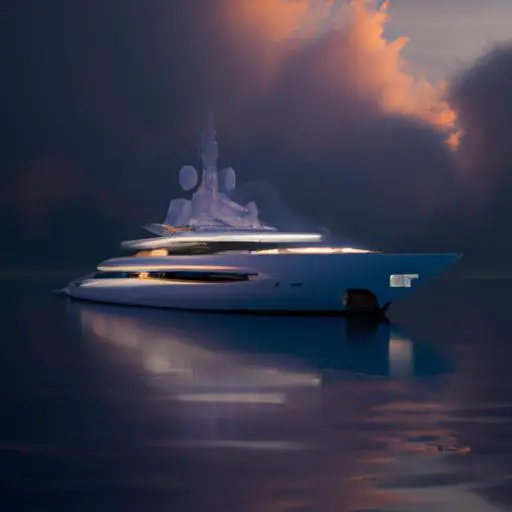
Ever wondered how much fuel a superyacht can hold? Have you been curious about the factors that determine a superyacht’s fuel capacity? Or maybe you’re interested in learning how to maximize fuel efficiency? Well, you’re in the right place! In this article, we’ll explore all of these topics and more.
We’ll dive into the different types of engines and fuel efficiency, the average fuel capacity of a superyacht, the largest fuel capacity for a superyacht, the benefits of having a larger fuel capacity, how to maximize fuel efficiency, and tips for conserving fuel.
So, let’s get started!
Table of Contents
Short Answer
The amount of fuel a superyacht holds varies greatly depending on the size and type of yacht.
Generally, a superyacht can hold anywhere from 5,000 to 30,000 gallons of fuel.
Larger vessels can hold up to 50,000 gallons or more.
Additionally, some superyachts are equipped with multiple fuel tanks to store more fuel for longer voyages.
Factors that Determine the Fuel Capacity of a Superyacht
When it comes to determining how much fuel a superyacht holds, there are a number of factors that come into play.
The size and type of the yacht are the two most important factors to consider.
Generally speaking, a superyacht typically holds anywhere from 15,000 to 50,000 gallons of fuel, though some larger vessels can hold upwards of 200,000 gallons.
The range and cruising speed of a superyacht, as well as the type of engines used on the yacht, are also key factors in determining the amount of fuel the yacht will need to store.
As a general rule, larger and faster yachts require more fuel to travel longer distances.
Additionally, the fuel efficiency of the yacht will also have an impact on the total fuel capacity.
The more efficient the yacht, the less fuel it will need to travel the same distance.
Finally, the purpose of the yacht will also play a role in determining the fuel capacity.
Yachts that are used for racing or long-distance cruising will need more fuel than ones that are used primarily for short-distance trips or pleasure cruising.
In addition, the fuel storage capacity of the yacht will be determined by the number of tanks installed and the size of the tanks.
Ultimately, the amount of fuel a superyacht holds will vary greatly depending on a variety of factors.
The size and type of the yacht, its range and cruising speed, the type of engines used, and the fuel efficiency of the yacht will all have an impact on the total fuel capacity.
Additionally, the purpose of the yacht and the size of the fuel tanks will also determine how much fuel a superyacht can hold.
Types of Engines and Fuel Efficiency

When considering the total fuel capacity of a superyacht, it is important to consider the type of engines and fuel efficiency of the vessel.
The type of engines used will impact the fuel efficiency and ultimately the amount of fuel the yacht will need to store.
Traditional diesel engines are typically more fuel efficient than gas-powered engines, and may require a smaller fuel capacity.
On the other hand, gas-powered engines may require a larger fuel capacity due to their lower efficiency.
Additionally, some superyachts feature hybrid propulsion systems, which combine diesel and electric power to achieve greater fuel efficiency.
In addition to the type of engine, the fuel efficiency of the vessel is determined by several other factors.
The yachts weight, hull shape, and speed all influence fuel efficiency, with lighter, more efficient hulls and slower cruising speeds allowing for greater fuel efficiency.
Additionally, the use of fuel-saving technologies such as advanced propellers and energy-saving sails can also improve fuel efficiency, allowing for a smaller fuel capacity.
Ultimately, the type of engines and fuel efficiency of a superyacht will have a significant impact on the total fuel capacity of the vessel.
By carefully considering these factors, it is possible to optimize a superyachts fuel efficiency and minimize the total fuel capacity required.
Average Fuel Capacity of a Superyacht
When it comes to the fuel capacity of a superyacht, the amount varies greatly depending on the size and type of the vessel.
Generally speaking, a superyacht typically holds anywhere from 15,000 to 50,000 gallons of fuel.
However, some larger vessels can hold upwards of 200,000 gallons.
The amount of fuel a superyacht holds is largely determined by the vessel’s range and cruising speed, as larger and faster yachts will require more fuel to travel longer distances.
In addition to the range and cruising speed of the vessel, other factors such as the type of engines, as well as the fuel efficiency of the yacht, can also have an impact on the total fuel capacity.
For instance, if the yacht has higher-performance engines, it may require more fuel to sustain the speed and range of the vessel.
On the other hand, if the yacht has more efficient engines, it may be able to cover more distance with less fuel.
In addition to the engine type and fuel efficiency, the type of fuel also plays a role in determining the fuel capacity of a superyacht.
Diesel-powered yachts typically have a higher fuel capacity than gasoline-powered yachts, as diesel engines are more fuel-efficient than their gasoline counterparts.
Additionally, some yachts may use a combination of diesel and gasoline engines, which can also affect the total fuel capacity of the vessel.
Finally, the fuel capacity of a superyacht can also be impacted by the design of the vessel.
Larger vessels may require more fuel tanks to hold the necessary amount of fuel, while smaller vessels may only need one or two tanks.
Additionally, the placement of the fuel tanks on the vessel can also affect the total fuel capacity, as some locations may be more efficient for storing fuel.
In conclusion, the amount of fuel a superyacht holds can vary greatly depending on a variety of factors, such as the size and type of the vessel, the range and cruising speed, the type of engines, the fuel efficiency, and the design of the vessel.
Ultimately, the total fuel capacity of a superyacht is determined by all these factors combined.
The Largest Fuel Capacity for a Superyacht

When it comes to fuel capacity, superyachts can hold anywhere from 15,000 to 200,000 gallons of fuel, depending on the size and type of yacht.
The largest and fastest yachts typically have the highest fuel capacity, as they are designed to travel longer distances and at higher speeds.
Larger vessels can hold up to 200,000 gallons of fuel, allowing them to travel thousands of miles without needing to refuel.
The type of engines and the fuel efficiency of the yacht can also have an impact on the total fuel capacity.
Many superyachts are equipped with high-performance engines, which are designed to be more fuel-efficient and to require less fuel to operate.
Additionally, some yachts are equipped with dual fuel engines, which are able to run on both diesel and gas, allowing them to switch between the two fuels depending on their needs.
Finally, the design of the yacht can also affect its fuel capacity.
Modern yachts are often created with a sleek and aerodynamic design, which helps them to reduce drag and increase fuel efficiency.
This means that the yacht can hold more fuel and travel farther on the same amount of fuel.
Additionally, these yachts often feature advanced fuel-saving technologies such as wind-powered generators and efficient propulsion systems, which help them to further increase their fuel efficiency.
Overall, the amount of fuel a superyacht holds can vary greatly, depending on several factors such as the size and type of yacht, the type of engines, the fuel efficiency of the yacht, and the design of the vessel.
Larger and faster yachts tend to have the highest fuel capacity, with some able to hold up to 200,000 gallons of fuel, while smaller and slower vessels typically have less fuel capacity.
Additionally, modern yachts are often designed to be more fuel-efficient, allowing them to hold more fuel and travel farther on the same amount of fuel.
The Benefits of Having a Larger Fuel Capacity
When it comes to superyachts, having a large fuel capacity can be incredibly beneficial.
For starters, having a larger fuel capacity means that the yacht can travel long distances without having to refuel.
This is especially important if the yacht is traveling in remote areas with limited access to fuel.
Additionally, having a larger fuel capacity allows the yacht to cruise at faster speeds, as more fuel provides greater power and acceleration.
Finally, having a larger fuel capacity can also reduce the yacht’s overall fuel costs, as more fuel means fewer refueling stops.
All of these benefits add up to make having a larger fuel capacity on a superyacht a worthwhile investment.
How to Maximize Fuel Efficiency

Making sure your superyacht is running optimally is the key to maximizing fuel efficiency and getting the most out of your fuel capacity.
First, make sure your engines are properly maintained and tuned, as regular service and repairs can help your boat run more efficiently and reduce fuel consumption.
Additionally, running your engines at the correct speed for the conditions can help you achieve better fuel economy.
If you are travelling at a lower speed, your engines will not need to run at full capacity, meaning you can save fuel.
It is also important to ensure that your yacht is properly loaded, as an overloaded vessel can be less fuel efficient.
If you are carrying more than the recommended load, it will take more fuel to propel the boat.
To maximize fuel efficiency, make sure you are only carrying the necessary items and are not overloading your yacht.
Finally, installing the latest technology and equipment can also help you maximize fuel efficiency.
Outfitting your vessel with the latest navigation systems, fuel-injection systems, and fuel-monitoring systems can help you track and monitor your fuel consumption and make sure you are running your engines optimally.
Additionally, investing in newer, more fuel-efficient engines can also help you get the most out of your fuel capacity.
Tips for Conserving Fuel
When it comes to conserving fuel on a superyacht, there are several important steps that can be taken to ensure maximum efficiency.
First, it is important to ensure that the engines are running optimally, as any issues with the engines can lead to an increase in fuel consumption.
This can be done by regularly inspecting the engines and checking the oil levels to keep them in good condition.
It may also be beneficial to install devices, such as fuel flow meters, that can help monitor fuel usage and ensure that the engines are running optimally.
Second, reducing drag and improving aerodynamics can help to reduce fuel consumption.
This can be done by making sure that all of the yacht’s systems, such as the propellers, rudders, and hulls, are in optimal condition.
Additionally, installing wind-catching devices, such as wind deflectors, can help to reduce drag and improve fuel efficiency.
Third, it is important to ensure that the yacht is properly loaded.
This means that the weight of the yacht should be evenly distributed and that all unnecessary items should be removed.
Additionally, it is important to ensure that the fuel tanks are not overfilled, as this can lead to fuel being wasted due to sloshing.
Finally, it is important to be mindful of the yacht’s route.
Taking a more direct route and avoiding areas with heavy currents, such as narrow straits and rivers, can help to reduce fuel usage.
Additionally, sailing during periods of favorable wind can help to reduce fuel consumption, as the yacht will be able to make use of the wind energy to help power the vessel.
Final Thoughts
It’s clear that the amount of fuel a superyacht holds can vary greatly depending on a variety of factors, from the size and type of yacht to the engine type and fuel efficiency.
The average superyacht holds anywhere from 15,000 to 50,000 gallons of fuel, and some of the largest vessels can hold up to 200,000 gallons.
Having a larger fuel capacity is beneficial for longer trips, but it’s important to consider how to maximize fuel efficiency and conserve fuel to make the most out of the fuel you have.
With the right knowledge and a few tips, you can ensure that your superyacht has the fuel capacity it needs to provide the best possible experience.
James Frami
At the age of 15, he and four other friends from his neighborhood constructed their first boat. He has been sailing for almost 30 years and has a wealth of knowledge that he wants to share with others.
Recent Posts
When Was Banana Boat Song Released? (HISTORICAL INSIGHTS)
The "Banana Boat Song" was released in 1956 by Harry Belafonte. This calypso-style song, also known as "Day-O," became a huge hit and remains popular to this day for its catchy tune and upbeat...
How to Make Banana Boat Smoothie King? (DELICIOUS RECIPE REVEALED)
To make a Banana Boat Smoothie King smoothie at home, start by gathering the ingredients: a ripe banana, peanut butter, chocolate protein powder, almond milk, and ice. Blend the banana, a scoop of...
- Motorcycles
- Car of the Month
- Destinations
- Men’s Fashion
- Watch Collector
- Art & Collectibles
- Vacation Homes
- Celebrity Homes
- New Construction
- Home Design
- Electronics
- Fine Dining
- Les Marquables de Martell
- Mira Villas
- Panther National
- Reynolds Lake Oconee
- Wynn Las Vegas
- 672 Wine Club
- Sports & Leisure
- Health & Wellness
- Best of the Best
- The Ultimate Gift Guide
This Fuel-Sipping Superyacht Can Travel More Than 6,000 Miles Between Fill-Ups
Feadship's new vitruvius-designed 190-foot najiba sets a new standard for superyacht efficiency., howard walker, howard walker's most recent stories.
- This 112-Foot Superyacht Has an Interior That’ll Make Your Manhattan Condo Jealous
- This 1967 Shelby GT500 Has Been Reimagined to Perfection. Now It’s up for Grabs.
- One of Ferrari’s Earliest Formula 1 Cars Is Now Up for Grabs
- Share This Article

Think of it as the Prius of the seas. Najiba , the newly completed, 190-foot all-aluminum superyacht built by Dutch craftsmen at Feadship from a Vitruvius Yachts design, sips fuel like the hybrid Toyota. Well, almost.
During recent sea trials, Najiba reportedly delivered a truly astonishing fuel consumption best of just three gallons per nautical mile at its 12-knot cruising speed. That’s despite this sleek and slender motor yacht tipping the scales at 880 tons and having a couple of muscly 1,448 hp MTU 12-cylinder diesels providing the power.
ISA Unveils a Trio of Sleek New Superyachts
This new 131-foot superyacht concept brings high architecture to the high seas.
- Tesla’s Cybertruck Inspired This New Solar-Powered Trailer
The secret, it seems, is down to the highly efficient hull design—that, and a single-minded focus on making the yacht slice through water like a hot knife through butter with minimal resistance.
The creative force behind Vitruvius , ace French designer Philippe Briand —one of his many fortes is drawing super-fast racing sailboats —penned the lines of Najiba’s lightweight alloy hull. He gave the yacht a wave-piercing plumb bow and maximum waterline, and closely worked with Feadship to reduce the effect of appendages like the propeller shafts, stabilizers and thrusters.
The real-world results that came out of the extensive sea trails included an increased top speed—from the original goal of 16 knots to 17—and a cruising-speed range of more than 6,000 nautical miles compared to the projected 5,000 miles. That’s Antibes to Miami with fuel to spare in the yacht’s 23,757-gallon fuel tanks.
The choice of using lightweight aluminum was also a major factor in increasing the yacht’s efficiency. The entire hull and superstructure were built using the alloy, while the yacht’s design called for a sleek, lower-than-usual wheelhouse to reduce wind resistance at speed.
“These results mean that despite the complexity of her development and build, we have outperformed all expectations with Najiba ,” explained Roderick de Vries, technical director of the Feadship yard in Aalsmeer, southwest of Amsterdam.

The entire hull and superstructure were built using lightweight aluminum. Photo: Courtesy of Feadship
“It was a real ‘wow’ moment for everyone involved to see this level of efficiency achieved during sea trials. It is one thing to design such an efficient full-displacement motor yacht, but another to translate these lines and shapes into a stunning Feadship that is even faster and more fuel-efficient than we projected.”

Najiba is the fifth Vitruvius-designed yacht. Photo: Courtesy of Feadship
Right now Najiba , which means “noble,” is with its new owner on a maiden voyage to Bergen in Norway. Chances are he won’t be looking to fill up any time soon.
Read More On:
- Philippe Briand
More Marine

Wider Yachts Is Debuting a 92-Foot Hybrid Catamaran at the Venice Boat Show—Here’s a First Look

Killer Whales Sunk a 50-Foot Sailing Yacht in the Strait of Gibraltar

Culinary Masters 2024
MAY 17 - 19 Join us for extraordinary meals from the nation’s brightest culinary minds.
Give the Gift of Luxury
Latest Galleries in Marine

K Superyacht in Photos

Meet ‘Home,’ the Sleek 164-Foot Superyacht That Starred in ‘Below Deck’
More from our brands, nypd is investigating death of brooklyn accessories designer, wnba investigating $100k bonus to each las vegas aces player, trustnordisk boards marjana jankovic’s ‘home’ (exclusive) , christie’s website still down hours before evening sales, causing concerns, the best yoga mats for any practice, according to instructors.

Do you operate a yacht? Our app is perfect for you
Yacht fuel cost calculator - how to estimate the costs.
Yacht captains have many responsibilities when it comes to the management of their vessel. One of them is keeping track of expenses, which is why it is important to familiarize yourself with the vessel’s operational costs. Keeping a luxury superyacht afloat isn’t cheap, and many claim that the average annual cost ranks up to 10% of the vessel’s price.
From these expenses, a significant portion goes to fuel. Filling up the tank of your boat is quite pricey, which is why a growing number of boat owners want to know exactly how much they are looking to spend for their upcoming voyage. This is also important for people who want to charter a boat for their holiday.
If you’re wondering how to best estimate the costs involved, you’re in the right place. This article will help you calculate your vessel’s yacht fuel cost while giving an overview of all the criteria used as variables. To make the process even easier, we link to a yacht fuel cost calculator to help you get an indication of the expenses you’ll need to cover. Let’s delve in!
Yacht fuel cost calculator
How to estimate yacht fuel costs, how much fuel does a yacht use.
- Price of boat fuel per gallon?
Yacht fuel formula
The easiest way to calculate your fuel costs is by using a yacht fuel cost calculator. There is a great calculator available here in case you want to save time and get an approximate estimation.

As you can see, the yacht fuel cost calculator has many variables which you need to be aware of before you set out to calculate the approximate price. This is what we will be dealing with in the next few chapters.
To help you get a better understanding of the calculation process we will do things manually while giving you the exact formulas used to calculate your vessel’s fuel needs. Therefore, make sure you keep on reading.
There are several things you need to keep in mind when you first set out to estimate the total fuel cost for your next voyage. These are summarised in the following points:
- Distance of journey - The total amount of nautical miles (or km)
- Cruising speed - The (average) speed of your vessel (in knots or km/hr)
- Fuel consumption - Understanding how many gallons (or liters) of fuel are consumed per hour
- Yacht fuel price - Understanding the average market price per gallon of fuel
The first two points depend solely on your needs and personal preference, which means that they are more flexible on a subjective basis. The latter two points may require a bit of research, especially if you’re not familiar with the engine of the vessel.
In the following sections, we will delve deeper into each of the points mentioned above, and offer the required formulas to help you calculate yacht fuel cost.
Calculating distance and speed
To understand the exact distance you are looking to cover in your next voyage, you can simply use Google Maps to plan your route. The following video explains the process in detail.
As soon as your route is planned out, you can measure the distance as well, selecting the preferred method of calculation. In our case, it is best to measure in nautical miles (1nm=1,85km), as this metric is more commonly used among sea men. The yacht fuel cost calculator above has an embedded map that helps you pinpoint the journey you want to make.
Next comes the cruising speed. The number is mostly calculated in knots (nautical miles/hr). The speed with which the vessel will cruise depends on the captain onboard, but is often influenced by the owner and guests onboard. You can make a rough estimation of this number based on previous trips.
Next, we need to calculate the amount of fuel that you will likely need. To do this we need to understand the engine type, its horsepower, and several other factors.
Let’s take a marine diesel engine for example. These engines are very common on motor yachts and consume approximately 0.4 pounds of fuel per hour for each unit of horsepower. You can find fuel consumption info for your specific engine by looking it up on the web or by calling the service number.
Once you know the fuel burn rate, it’s best to add a relative error margin of 10% based on minor factors. These include weather conditions, vessel size, and drag, all of which can increase the fuel burn.
How much fuel does a yacht use per hour?
Now that you know all the variables you can go ahead and calculate the amount of fuel that your yacht will need.
- Start by calculating the fuel burn per hour based on the horsepower of the engine.
- Add a multiplier based on the cruising speed of your vessel.
A vessel with a diesel engine of 300 horsepower will most likely burn 16-17 gallons per hour, which you can then use as a guideline when calculating the travel time based on the nautical miles you are looking to cover.
Superyachts are consuming much more fuel. An average 70-meter luxury yacht will burn around 130 gallons per hour with the engines running, while the amount increases significantly when the ship is moving. On average, you are looking at ±€2000 per hour (±1000 gallons) to achieve a speed of 20 knots. Of course, the higher the cruising speed, the more fuel you will be burning per hour, which in turn makes each hour at sea more expensive.
How much does boat fuel cost per gallon?

The exact price you are looking to pay per gallon depends on the marina you find yourself in. By looking at several price points of marinas, we get the following:
- Average diesel prices range from $3.2-$3.9 per gallon
- Average petrol prices range from $7.2-$7.8 per gallon
Note that discounts usually apply whenever you choose to purchase large quantities of fuel.
Why is boat fuel so expensive?
Marine fuel pricing is heavily inflated due to low supply and high demand. In short, the limited number of fuel stations at marinas have to service all the yachts that dock, which leads to a no-choice monopoly.
That said, yacht owners are usually not that concerned about the small price spike that marinas charge as an extra. If anything, they are happy to pay due to the convenience of the service.
How much fuel does a yacht hold?
Once again, the answer to this question depends on the size of the vessel. Smaller yachts can hold around 1300 gallons of fuel, while the bigger vessels can store up to 100,000 gallons. The ship’s engineers should be able to provide this number for the vessel you command.
Now that we have a better understanding of all the variables that determine the cost of fuel, we can go ahead and take you through the calculation process step by step.
First, know the total duration of your cruise. To obtain this information, divide the number of nautical miles by the cruising speed of your vessel (knots). For example, if you want to make a journey that totals 150 nautical miles while traveling at 20 knots, the yacht fuel formula looks as follows:
Total duration = 150 nm / 20kn
Total duration = 7,5 hrs
Note that the amount of fuel consumption may end up higher than expected if:
- Sea and weather conditions are not favourable
- You plan to make short stops along the way while the engine keeps running
Next, what you want to do multiply the number of hours by the number of gallons that your engine burns on an hourly basis while moving at the speed you previously indicated. If we take, as an example, the superyacht mentioned in the previous examples, we would make the calculation as follows:
7,5 hrs x 1000 gph = 7500 gallons
Now assume that you will also make two stops along the way, an hour and a half each, in order to let the guests enjoy their time; maybe ride a jet ski.
You then multiply the added number of hours with the consumption rate of a running engine. In this case:
3 hrs x 130 gph = 390 gallons
All that is left to do now is add up the total amount of fuel needed and multiply the number with the price per gallon.
(7500+390) x $3,5 = $27615
In this example, the final cost of your will set you back a little bit more than 27 thousand dollars. Just to be safe, calculate the additional 10% (margin of error) to be prepared against unexpected mistakes. This added amount is not necessarily an ad-on when you consider chartering. Private yacht owners, however, should add the amount to their final cost.
And that's it! You should now have a better idea on the steps you need to follow to calculate the fuel costs for your yacht. While there is quite a bit of information you should keep in mind, it is best to plan out everything with detail to avoid unforeseen costs. If you enjoyed this article, check out our blog post on yacht electrical systems as well.

How much fuel does it take to fill the world's largest superyacht?

Ever wondered how much fuel it takes to fill up the world's largest superyachts? We have. That's why we decided to compare the fuel tank capacity of the world's current largest superyacht with some smaller vehicles and craft that are a little closer to home.
Lürssen's M/Y Azzam currently holds the title of the largest superyacht in the world, and has retained this status since her delivery in late 2013. At over 180 metres (590 feet) in length, she has a 50-person crew and weighs over 13,000GT, yet she is still able to clock up impressive speeds of up to 30 knots.
She is owned by the president of the United Arab Emirates, and amongst other features suited to this class of boat, is fitted with her own missile defence system.
Given the sheer scale of Azzam, we decided to look at how much fuel she can take, and how that compares to the things we’re more familiar with fuelling up ourselves...

That’s the equivalent of refilling a typical hatchback car more than 23,800 times, and the same amount of fuel could fill up almost six Boeing 747 commercial airliners.
Likewise, it would take the fuel of 3,636 London double-decker buses or 167 24-metre (78-foot) yachts to fill Azzam.
So in answer to the question 'how much fuel does it take to fill the largest superyacht in the world?', the answer is: a lot!
If you have a superyacht to fill, you can search for yacht fuel suppliers in your location, or read more superyacht fuel articles .
Tried & Tested

Yachting Pages has put several of the leading safety cases (and other associated products) to the test. The objective: to ascertain how each product performs and determine which one is best equipped to safely contain a lithium battery-induced fire.
In the realm of maritime luxury, the quest to offer yacht charter guests the perfect night's sleep has become an art form, one which luxury bed and linen supplier, CC Design, has fully committed to.
A jacket completes any crew member's uniform so it's an important garment to get right. In this Tried & Tested, Sea Design pits eight popular jackets against one another to determine which one is best for superyacht crew in 2023.
Ocean Property announce partnership with Siam Seaplane, launching a seaplane facility at Ocean Marina Jomtien, Chonburi....

Leading biotech cleaning company Washdown has initiated a new campaign aimed at eradicating Volatile Organic Compounds (...

Popular Articles
Finished reading now find your perfect supplier..
Search our industry-leading directory for over 20,000 superyacht suppliers, providers and marinas.

A GUIDE TO YACHT FUEL: WHAT YOU SHOULD KNOW

Yacht fuel, a vital element for powering watercraft and setting sail into the open waters, plays a crucial role in the maritime industry. Whether you're a seasoned yachtie or a sailing enthusiast, understanding the intricacies of yacht fuel is essential. This article serves as a guide, shedding light on the types of yacht fuel, fuel efficiency, environmental concerns, and more.
What types of yacht fuel are there?
Yachts predominantly rely on two types of fuel - gasoline and diesel.
Gasoline: Typically used in smaller recreational boats and yachts, gasoline is a highly volatile fuel that requires careful handling and storage. It is commonly employed in outboard engines due to its lighter weight and ease of ignition.
Diesel: Larger yachts and commercial vessels usually favor diesel fuel. It offers superior fuel efficiency and is considered safer to handle than gasoline. Diesel-powered yachts are known for their long-range capabilities and lower fuel consumption.
Fuel Tanks and Storage
Yachts are equipped with onboard fuel tanks responsible for storing fuel during voyages. The size of these tanks varies widely depending on the yacht's dimensions, intended use, and range requirements. Proper storage and maintenance of fuel tanks are essential to ensure the safety and efficiency of the vessel.
Fuel Consumption and Efficiency
The fuel consumption of a yacht is influenced by several factors, including:
· Yacht Size and Weight: Larger and heavier yachts typically consume more fuel than their smaller counterparts.
· Engine Type: The type and efficiency of the engines play a significant role in determining fuel consumption.
· Cruising Speed: Operating the yacht at higher speeds can significantly increase fuel consumption.
With environmental concerns becoming more prominent, the yachting industry has seen a surge in efforts to improve fuel efficiency. Manufacturers and designers focus on innovative technologies to reduce emissions and enhance fuel economy, making yachting more sustainable.
Fueling Stations and Prices
Marinas and ports worldwide offer fueling stations where yacht owners can replenish their fuel supply. These fueling facilities cater to both gasoline and diesel-fueled yachts. The prices of yacht fuel can vary based on the location, global oil prices, and local taxes. Many yacht owners plan their journeys strategically, taking into account the availability and cost of fuel at different ports.
Environmental Considerations
The impact of marine vessels, including yachts, on the environment has garnered increased attention in recent years. Emissions from combustion engines, fuel spills, and potential marine life disturbances are among the concerns. As a result, there is growing interest in exploring eco-friendly alternatives to traditional yacht fuel.
In response to these concerns, the yachting industry invests in developing sustainable technologies, such as hybrid propulsion systems, electric motors, and biofuels. The aim is to reduce the carbon footprint and minimize environmental harm while maintaining the luxury of yachting.
What does fuel consumption depend on?
Fuel consumption in various vehicles, including yachts, depends on several factors. The primary factors that influence fuel consumption are as follows:
· Vessel Type and Size: The type and size of the vessel play a significant role in fuel consumption. Larger and heavier vessels typically require more fuel to move and maintain their momentum.
· Engine Efficiency: The efficiency of the engine directly impacts fuel consumption. Modern engines equipped with advanced technologies tend to be more fuel-efficient than older, less sophisticated ones.
· Driving Speed: Fuel consumption increases at higher speeds. Driving at higher velocities requires more energy to overcome air resistance, resulting in higher fuel consumption.
· Load and Cargo: Carrying heavy loads or excessive cargo can cause the engine to work harder, increasing fuel consumption.
· Weather Conditions: Extreme weather conditions, such as very hot or very cold temperatures, can affect fuel consumption. In colder weather, engines might take longer to reach their optimal operating temperature, thus reducing efficiency.
· Maintenance: Regular maintenance, including air filter replacement and engine tune-ups, ensures optimal engine performance and improved fuel efficiency.
· Fuel Type: Different fuel types, such as gasoline and diesel, have varying energy densities, which can affect fuel consumption.
As the yachting industry continues to evolve, embracing environmentally friendly practices and technologies will shape a brighter future for yachting enthusiasts, ensuring that the splendor of sailing is preserved for generations to come.
For further discussion and insights on this topic, check out the Main Deck to engage with other industry professionals and stay informed.
Yachting Monthly
- Digital edition

How it works: all about a yacht’s fuel system
- Callum Smedley
- October 27, 2023
Diesels Afloat co-author Callum Smedley takes a detailed look at the workings of a yacht's fuel system

A yacht’s fuel system comprises everything from the boat’s fuel tank to the engine’s fuel injector or injectors. There are two distinct parts of the fuel system: that installed by the boatbuilder and that attached to the engine. The tank, primary filter and all the pipework to and from the engine are designed and installed by the boatbuilder. From the lift pump onwards, it’s a complete unit from the engine manufacturer.
On older boats, you may find modifications to this part of the system, so investigate yours thoroughly to see if you need to bring it up to scratch. One of the biggest problems is leaking pipes, usually caused by vibration. Generally, however, apart from routine servicing and wear and tear, there should be little trouble from the fuel system. The main job is to simply supply the engine with clean and water-free fuel.
The fuel itself is a hydrocarbon that mainly comes from crude oil. We usually call it diesel oil or ‘red diesel’ (with no duty to pay), but its proper name is marine gas oil. Apart from having red dye added to it, to identify that it is duty-free, marine fuel is very similar to road diesel fuel, often called ‘white diesel’ (on which duty must be paid), used in cars, lorries and buses.

Your boat’s diesel engine will run perfectly fine on either fuel, but white diesel contains biodiesel which can clean out your fuel system due to its higher solvent content. Cleaning out the fuel system may sound good, but the dirt released has to go somewhere, so it ends up in the fuel filters. The fuel filters will remove the dirt effectively but it means they will have to be changed much more often. In any case, it’s always a good idea to carry extra filters on board.
Copper pipework
The pipework in a yacht’s fuel system is most often made from copper. However, over time it can become hardened and brittle, especially if it isn’t supported or clipped properly to the vessel, making it much more likely to crack, which, in turn, can lead to a loss of fuel into the bilges or the pipework failing completely. Fuel in the bilges is never a good idea, because of fire and pollution. If the fuel piping was to fail completely the engine would stop, and it shouldn’t be re-started until a full repair is carried out with the system completely bled of air – one reason why commercial vessels are now starting to use stainless steel pipes.
Flexible pipework
When an engine is mounted on flexible mounts, flexible fuel pipework (hoses) should be used, and it’s vital that the correct grade of hose is used. The suitable grades are;
BS EN 853 rubber covered wire braided reinforced hydraulic type BS EN 856 rubber covered spiral wire reinforced hydraulic type ISO 7840 fire-resistant flexible oil fuel hose.
Normally, there will be text on the hose indicating that it is suitable for fuel.
Enjoyed reading this?
A subscription to Yachting Monthly magazine costs around 40% less than the cover price .
Print and digital editions are available through Magazines Direct – where you can also find the latest deals .
YM is packed with information to help you get the most from your time on the water.
- Take your seamanship to the next level with tips, advice and skills from our experts
- Impartial in-depth reviews of the latest yachts and equipment
- Cruising guides to help you reach those dream destinations
Follow us on Facebook , Twitter and Instagram.
Switch language:

Azzam Superyacht
Azzam Superyacht, delivered in October 2013, replaced the Eclipse Superyacht as the largest superyacht in the world.
Constructor
Fr. Lurssen Werft
Exterior Designer
Nauta Design
Interior Designer
Christophe Leoni
Length of Azzam
October 2013
Two diesel engines rated at 23,000HP

Azzam was launched at Lurssen Shipyard in Bremen, Germany, in April 2013. Upon delivery to its owner in October 2013, the yacht created a significant landmark in yacht building, involving less than three years of construction and one year of engineering activities.
Recommended White Papers
AIDAnova Put to the Test
Sustainable water solutions for the marine industry, recommended buyers guides.
Sustainable Shipping Companies and Solutions
Leading robotics companies in the shipping industry.
The owner of the yacht is Sheikh Khalifa bin Zayed Al Nahyan, the President of the United Arab Emirates and Ruler of Abu Dhabi. The yacht’s construction cost more than $600m. The name of the yacht, Azzam, means determination in Arabic.
The exterior design of the yacht was provided by Nauta Design, while interior design was by Christophe Leoni. Fr. Lurssen Werft was responsible for the engineering and construction of the Azzam superyacht. Technical engineering activities were carried out under the leadership of Mubarak Saad al Ahbabi.
Development of the world’s largest superyacht
The yacht was transferred from her original dock at Lurssen Shipyard, measuring 170m, to a larger dock, measuring 220m, in May 2012. Steel cutting for the yacht was held in late 2009.
The yacht successfully completed sea trials in June 2013, prior to its commissioning.
Dimensions of the superyacht
The Azzam measures 180m long, and has a beam of 20.8m and a maximum draft of 4.3m. The hull of the world’s larget yacht is made of steel.
The yacht is larger than the Eclipse by 17.2m. The Eclipse, which was commissioned in 2010, is owned by billionaire Roman Abramovich.
Azzam superyacht has a gross tonnage capacity of approximately 14,000t and features a fuel tank with a capacity of one million litres.
Its main salon measures 29m in length, with its beam measuring 18m. The salon on-board the yacht has an open space featuring no support pillars. The yacht features approximately 50 suites with no large open spaces on the deck, with the interior design of the vessel incorporating the Empire Style.
Azzam superyacht layout and facilities
The interior design of the yacht is highly confidential, but initial photo releases suggest that it features six decks. The rear view of the vessel also suggests that it is powered by jets.
The yacht is capable of providing accommodation facilities for at least 50 professional crew members. Similar to other yachts constructed by Lurssen, Azzam is environment-friendly with decreased carbon dioxide, noise and soot emissions, as well as enhanced fuel-efficiency.
Azzam is also believed to include facilities to use waste heat from the engine to operate the yacht’s desalination system for drinking water. Lurssen has been lauded for being the first yacht-builder to implement this system.
Engine details
The yacht features two gas turbines and two diesel engines with a rated power output of 23,500hp. The yacht can sail at a maximum speed of 30k.
Related Projects
More Projects
Adventure of the Seas, Voyager-Class Cruise Ship
Mayflower autonomous research ship (mars), port of rotterdam, pioneering spirit heavy-lift construction vessel, sign up for our daily news round-up.
Give your business an edge with our leading industry insights.
Sign up to the newsletter
Your corporate email address.
Ship Technology In Brief
Ship Technology Global
I consent to Verdict Media Limited collecting my details provided via this form in accordance with Privacy Policy
Thank you for subscribing
View all newsletters from across the GlobalData Media network.
Ever wondered how much it costs to fuel a $600 million superyacht? Hint – For that money, you can actually get an apartment in Manhattan and a Tesla Model S.
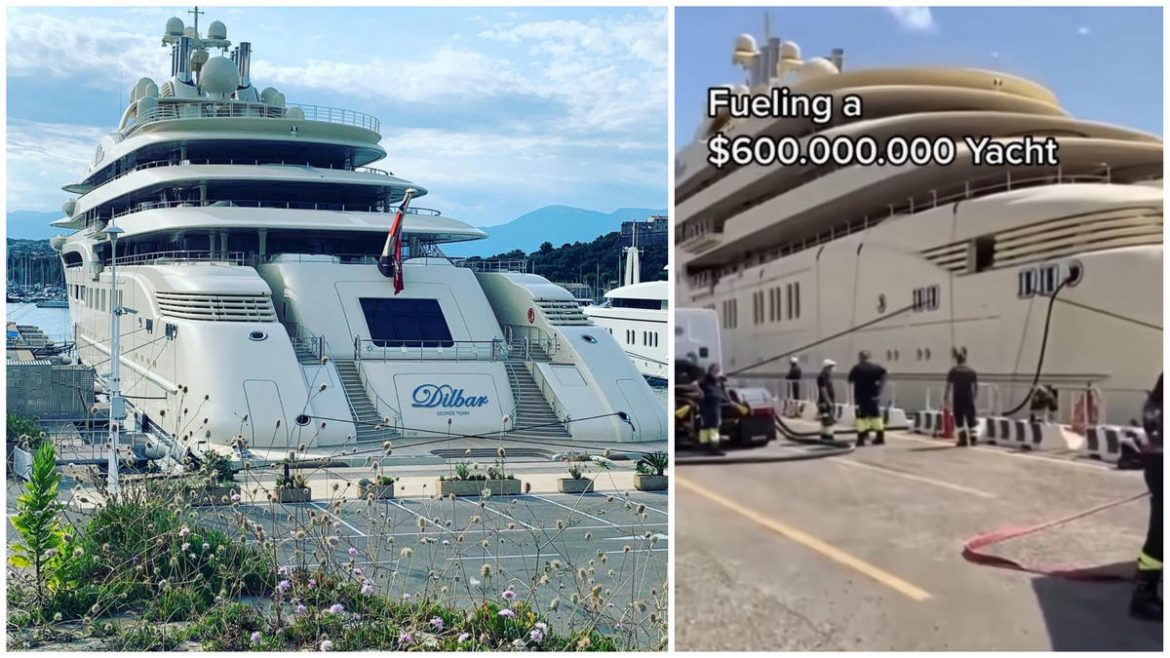
The things we associate with superyachts – size, grandeur, and billionaires; but never bills! If buying a megayacht is a big feat, then maintaining the behemoth deserves a trophy too. Many world-renowned superyachts cost hundreds of millions (Dilbar is worth $600 million), but have you ever wondered how much it costs to get these floating beasts of the seas from one point to another? Dilbar yacht is considered one of the largest yachts in the world in volume. It was record-breaking owing to its incredible technology and the sheer size and was launched by German shipyard Lürssen in 2016. The fourth-longest yacht in the world that can house a crew of a hundred people also flaunts a total fuel capacity of 1,000,049 liters. By comparison, the Airbus A380 which is the worlds largest commercial aircraft needs 372,800 liters of fuel to tank up.
View this post on Instagram A post shared by Denis S (@theyachtmogul)
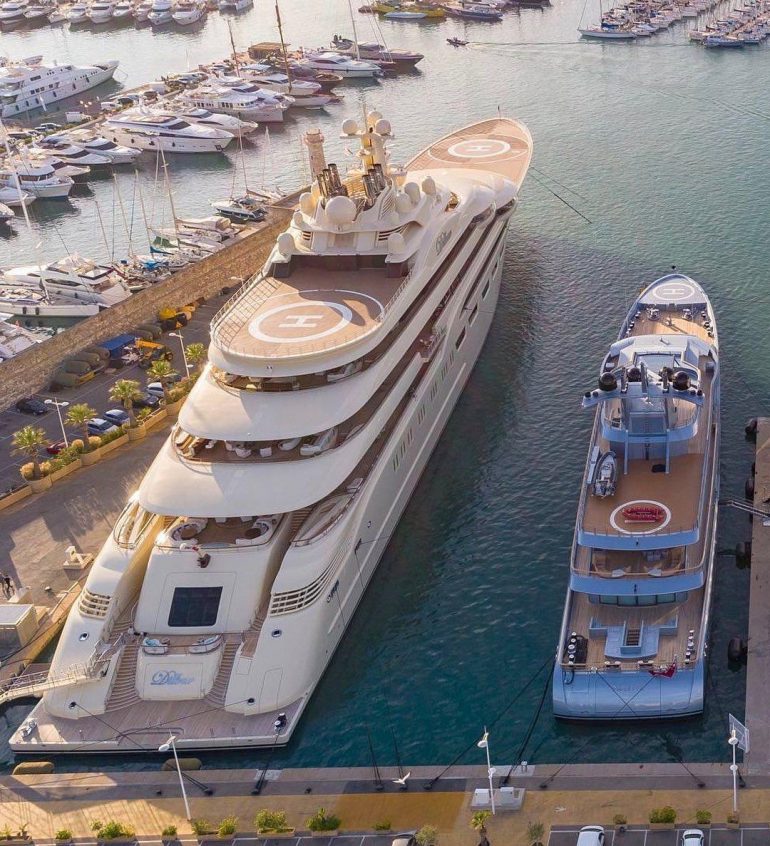
Note – The price of a Tesla Model S is $89,000 and a 690 sq ft 1 bhk apartment in 25, Broad Street, NYC costs $760,000.

You may also like
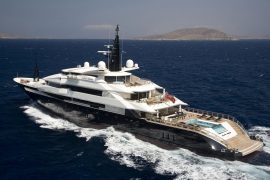
The $120 million abandoned superyacht Alfa Nero may finally be auctioned as the country of Antigua has secured the license from US authorities to sell the Russian billionaire’s 269 feet long vessel.
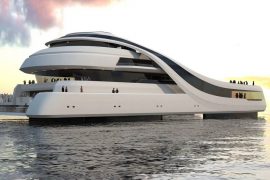
This 223 feet long superyacht concept has been specifically designed for a self-made Chinese billionaire in her 30’s – Created on the principles of Feng-Shui, the vessel has a health deck, a garden, and a laboratory for ocean research.
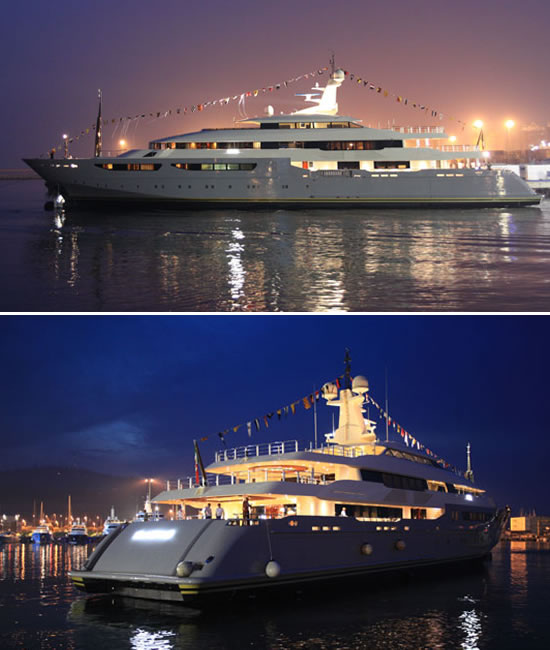
Azteca mega yacht from CRN is a $83 million luxurious delight

Not only one of the largest but this 330 feet long sailing superyacht concept will also be one of the greenest in the world – Its electric propulsion system matched with two rotating wing masts will save 225,000 liters of fuel per year.

From parties in private jets to unwinding in superyachts and casual days spent in supercars – This Instagram account shows how ultra-rich millionaires are setting travel goals on land, sea, and skies!
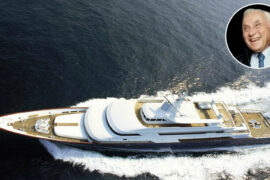
He started with a $5,000 loan from his aunt and went onto make billions from Victoria’s Secret and Bath & Body works. Take a look at Leslie Wexner’s 316-feet long superyacht Limitless which was once the largest yachts in the world.
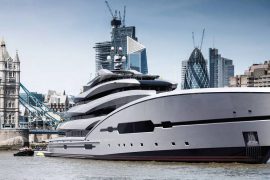
This 295-foot superyacht concept is inspired by the 1970s-era Le Mans racecars – The master suite stretches for 46 feet and has an island bed. Keeping guests entertained is a counter-flow swimming pool, cinema, high-tech gym, and more.


Jeff Bezos’ superyacht Koru has moved away from the oil tankers and is now anchored near Larry Ellison’s former $400 million superyacht ‘The Rising Sun’.
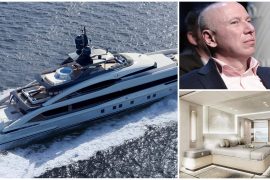
Along with his $1.3 billion megayachts Eclipse and Solaris, Roman Abramovich owned a rather modest $40 million superyacht. Incidentally, he passed the ownership of the 165-ft long vessel to his close friend exactly on the day Russia invaded Ukraine.

- Charter & Brokerage
- Yacht Design & New Builds
- Tenders & Toys
- Superyacht Events Calendar
- Career & Training
- Departments
- Superyacht Crew Finances
- Sustainability
- Shipyards and Marinas
- Health & Wellbeing
- Polar Region
- Our Services
- Meet the Team
Yachts And Fuel – How Much Do They Really Consume?
.png)
Fuel is one of many annual running costs of a yacht. Not only does the yacht need fuel for cruising; the generators require it to keep the vessel running while at anchor and underway. As well as this, many of the water sports toys require it too.
Some yachts cross the Atlantic Ocean twice a year between the Mediterranean and Caribbean while others embark on world cruises. That equates to a lot of fuel.
So How Much Do They Really Consume?
According to the Yachting Pages, the longest Superyacht in the world, 180m M/Y Azzam, holds 1,000,000 litres of fuel. To put it into perspective, that is the equivalent of filling a regular hatchback car 23,800 times. Or, six Boeing 747 commercial airliners.
West Nautical’s Vessel Manager, Tony Hildrew, a former Yacht Chief Engineer said:
“Fuel is the single biggest expense when it comes to yacht operations, it is estimated that the global spend on fuel is around $150bn annually however this shouldn’t put you off, there are a number of ways to ensure your fuel consumption doesn’t get out of hand. Implementing a Ships Energy Efficiency Management Plan or SEEMP for short is a great way to keep fuel costs down without compromising on your cruising experience.”
Each yacht will consume fuel differently for a number of reasons. It could be the size and make of the engines. Or, how often the yacht is using generators. As well as the number of tenders and water sports toys on board that require fuel. For example, if the yacht is out at anchor and running on generators 90% of the time, the fuel consumption will be much higher than a yacht that is in a marina at night and connected to shore power and water.
Another factor that will affect fuel consumption is the yacht’s itinerary. This is because the sea conditions will impact how much fuel the engines consume.
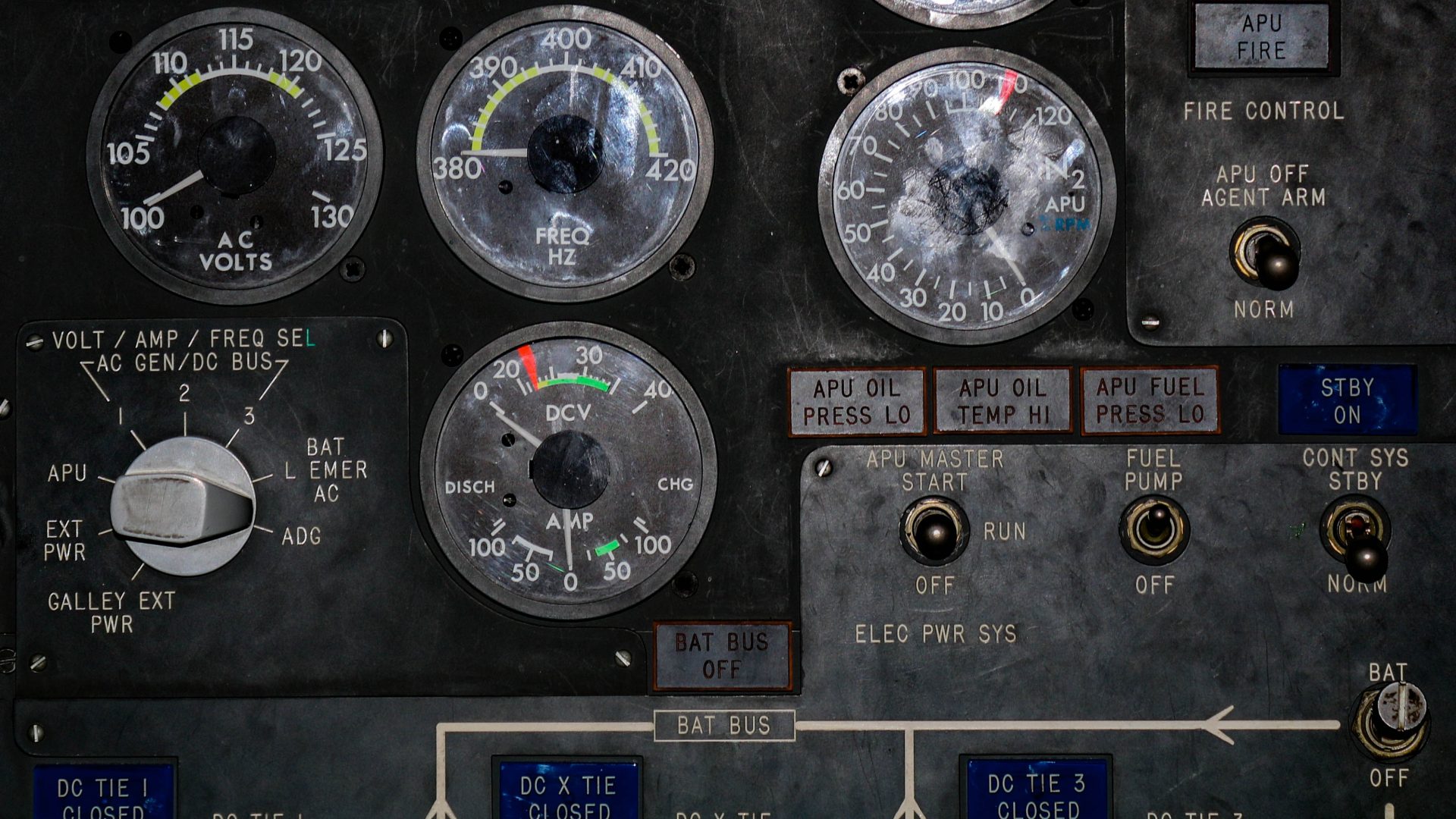
How Is Consumption Measured?
You will be able to input the start and ending points of your cruise on the map. This will automatically update the distance table. The next step is to enter the speed, fuel consumption and cost of fuel per litre to determine the cost of the trip.
Here is an example: A fast 30m yacht cruising at 20 knots will consume roughly 400 – 500 litres depending on the engine type. This would equate to the total consumption of 2500 litres for a distance of 100 nautical miles.
Another example is, a 70m yacht looking to travel 100 nautical miles with the engines burning 1000 litres per hour would add up to a total consumption of 8335L for that passage. Depending on where the yacht bunkered, the estimated cost with the price per litre being on the low end at €0.90 per litre would cost a total of €7501.50. An example of a 100 nautical mile passage would take you from Saint Tropez to The North Coast of Corsica.
How Much Does It Cost?
Fuel prices fluctuate depending on which country you bunker in and some places you bunker offer tax free fuel such a Gibraltar and Montenegro. Fuel prices can vary but typically costs between €0.80 and €1.30 per litre.
Yacht charter, sales and management company West Nautical added:
“Fuel costs should be at the top of any yacht owner and captain’s minds for two reasons: to minimise costs as well as reduce the environmental impact of burning unnecessary fuel. The superyacht charter market, more than most other markets, relies on pristine waters for their guests to enjoy their holiday. If the oceans in popular charter destinations are not maintained, it will decrease the demand for yacht charter and therefore the revenue for owners.” “If you are looking for expertise in operational management and engineering in order to plan a SEEMP, West Nautical would be delighted to assist.”
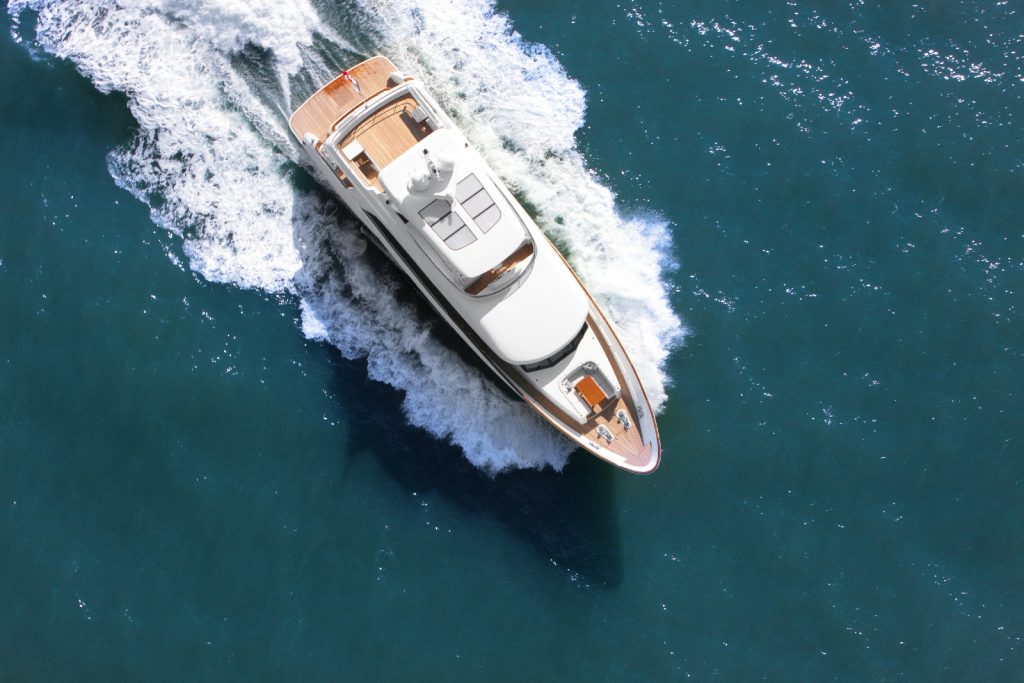
About West Nautical
West Nautical sell, charter and manage superyachts from their head office in Newcastle upon Tyne. The business currently employs a team of 21 staff throughout their offices based in the UK, Russia, France and Cyprus.
Since their inception over 25 years ago, West Nautical have become recognised as one of the most respected, trusted, knowledgeable and accountable professional services firms in yachting – largely due to their relentless determination to act in our clients’ best interests. Their approach and attitude is transparent, refreshing and focused on providing value-added services delivered simply, elegantly and affordably.
Visit West Nautical’s website here: https://westnautical.com
For Media enquiries please contact sarah.mackenzie@westnautical.com
To keep up to date with the latest Superyacht Content News, click here .
Sign up to our Newsletter below:
Newsletter Signup
- Your Name First Last
- Your Email *

West Nautical
Related articles, your guide to solas tenders, tender of the week: paragon g25, waves of wellness: a yacht crew’s guide to staying fit & happy, the crew network – top jobs this week.

Popular articles

Superyacht Content
Social media influencer and digital brand expert.
Superyacht Content brings you the latest in social news for the superyacht industry.
Keep up to date with us across our social channels, and don’t forget to hit that share button!
- Superyacht News
- Superyacht Jobs
- Superyacht Marketing
Join our Newsletter
Copyright © 2023 Superyacht Content | Website Design by Zonkey
Privacy | Credits | Get in Touch

Boat Gas Tank Size (With 60 Examples of Different Boat Models)
One of the most important things to know about a boat is the size of the gas (fuel) tank. Of course, gas tank sizes can differ between brand and model. In this article, we will walk you through the fuel capacities of different boat models in a detailed way with examples.
On average, a boat can hold around 40 gallons of gas in its fuel tank. But the range can vary from as small as 5 gallons or less for a small boat to as big as 250,000 gallons or more for a big yacht. Yet, most brands allow buyers to customize the boat accordingly, worrying less about fuel volumes.
Boats are not as fuel-efficient as cars. They consume a lot of gas compared to other vehicles due to their traversing in the waters. That’s the main reason why boats have bigger fuel tanks compared to other land-moving vehicles.
Many small boats tend to use 3-8 gallons of gas per hour at cruising speeds, while faster boats like speed and motorboats can use 25-40 gallons an hour. Depending on the boat’s weight, design, and, very importantly, the type of motor it has, the fuel burning rate changes drastically.
An older boat with an older engine will have poor fuel mileage when compared to more modern boats. Here’s a table showing the sizes of different boat models and their average fuel capacities range.
Those are the average fuel capacities for different boat models. OKAY, without further ado, let’s see the fuel capacities of those different boats in a detailed way.
Related post – What Fuel Do Boats Use? Check this article to know the types of fuels used in boats and their advantages & drawbacks in a detailed way.
How Many Gallons Of Gas Does A Speedboat Hold?
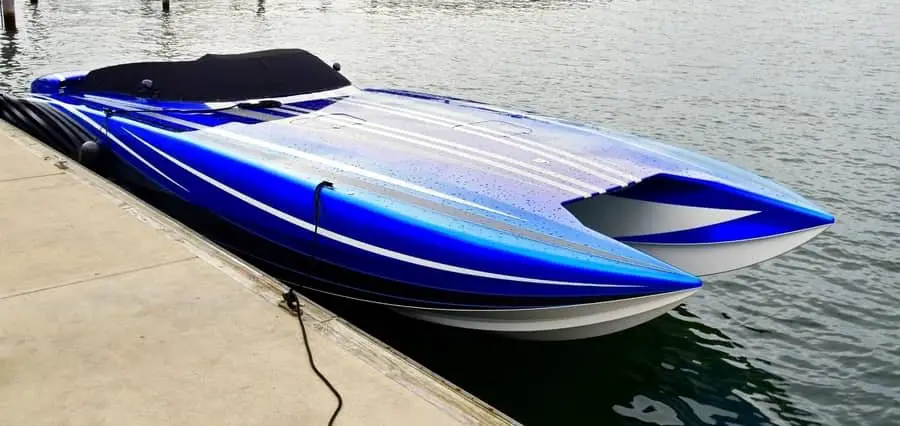
On average, a speedboat can hold around 250 gallons of gas in its fuel tank. But the range can vary from 150 gallons or less for a small speedboat to 1,000 gallons or more for a big speedboat. Yet, most brands allow buyers to customize the boat to their needs, worrying less about fuel capacities.
Those values may sound very big compared to other boats, but at their burning rate (which is, by the way, around 25 – 40 gallons an hour), they are comparable with normal boats with smaller tanks. Here’s a table showing the fuel capacities of different speedboat models.
A speedboat can cost around $350,000 on average. But depending on the model, amenities, speed, and the make you are looking for, the price may vary from as low as $100,000 or low to as high as $4,000,000 or more. Also, the price drastically depends on the “BRAND” rather than just the “SPEED.”
High-performance boats, also known as go-fast boats, racing boats, cigarette boats, powerboats, etc., are speedboats used in racing, recreational, luxury, law enforcement, and many other applications. By conventional standards, a high-performance boat is one that tops 60 mph.
But many of the speedboats in the market today easily hit 80+ mph. At that speed, the fuel burns very quickly. That’s why most of the speedboats have very big tanks compared to other small boats.
Related post – How Much Does A Speedboat Cost? Check this article to know the average costs of a speed boat with 15 examples in a detailed way.
How Many Gallons Of Gas Does A Pontoon Boat Hold?

On average, a pontoon boat can hold around 30 gallons of gas in its fuel tank. But the range can vary from 10 gallons or less for a small pontoon to 60 gallons or more for a big pontoon boat. Yet, most brands allow buyers to customize the boat to their needs, worrying less about fuel capacities.
The average pontoon boat will consume around 5 gallons per hour at cruising speed. This means that a five-hour trip out on the water will take 25 gallons of gas.
And it is very common to see a pontoon boat under 20ft with less than a 10-gallon tank. Many pontoon boats come with fuel tanks that are insufficient for the boater’s needs.
Since pontoon boats are not deemed for racing or speed, many manufacturers won’t give bigger tanks. Therefore, many pontoon boat owners replace an existing tank with a bigger one or add a tank to their boat. Here’s a table showing the fuel capacities of different pontoon boat models.
Pontoon boats are very popular among the boats. Their simple construction of the deck on two or three pontoon tubes makes it a very special boat. Two pontoons for most of the boats, but three pontoons go under the deck if the boat becomes larger and heavier.
Common pontoon boat designs are a catamaran with two hulls or a trimaran with three hulls. Boats with three hulls are sometimes called tri-toons. Pontoon boats are used for pleasure on lakes and rivers, and in some cases, on oceans close to shore.
Different pontoon boats have different-sized tanks. Most new pontoon boats will have a fuel capacity between 20 and 35 gallons. But most used pontoon boats will not have the same capacity unless the tanks have been upgraded by the current or previous owner ( source ).
Related Post – Do Boat Use The Same Gas As Car? Check this article to know the difference between the boat and car gasoline in a detailed way.
How Many Gallons Of Gas Does A Bass Boat Hold?
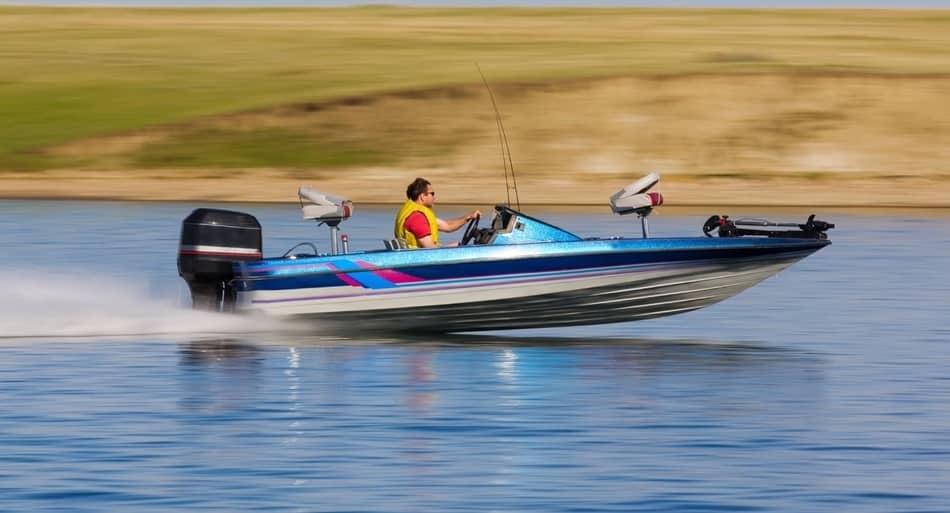
On average, a bass boat can hold around 40 gallons of gas in its fuel tank. But the range can vary from 20 gallons or less for a small bass boat to 70 gallons or more for a big bass boat. Yet, most brands allow buyers to customize the boat to their needs, worrying less about fuel capacities.
A bass boat is a small boat that is designed and equipped primarily for bass fishing or fishing for other panfish , usually in freshwaters such as lakes, rivers, and streams. Unlike some other boats, the bass boat promised a focus on fishing and nothing more.
An average bass boat will consume between 4 – 5 gallons per hour at cruising speed. Each angler is going to have their own preferences and desires for their bass boat. So let’s get into it. Listed here, we have some of the best bass boat models on the market, so let’s see how they compare when stacked up.
Bass boats are usually propelled by two means: an outboard motor, which moves the boat swiftly from place to place, and a trolling motor, which moves the boat at a slow pace through an area where the angler is fishing, requiring more gas.
Bass boats typically feature aerated livewells, a flat deck, and a powerful outboard engine. The whole idea of this boat is to allow for the best possible fishing experience. The deck is completely flat, and the form of the boat is very low to the water. This allows for great control of the boat in high wind situations and in shallow waters (which is the ideal place for fishers). Outdoor Troop
A Bass Cat Puma FTD SP has a 52-gallon fuel tank that allows for easy, stress-free adventure on the water. The maximum horsepower (max HP) of this fishing machine is 250 HP. This means that with this fuel capacity and horsepower capacity, you’ll have the ability to zoom across the water at over 70 mph.
How Many Gallons Of Gas Does A Cabin Cruiser Hold?
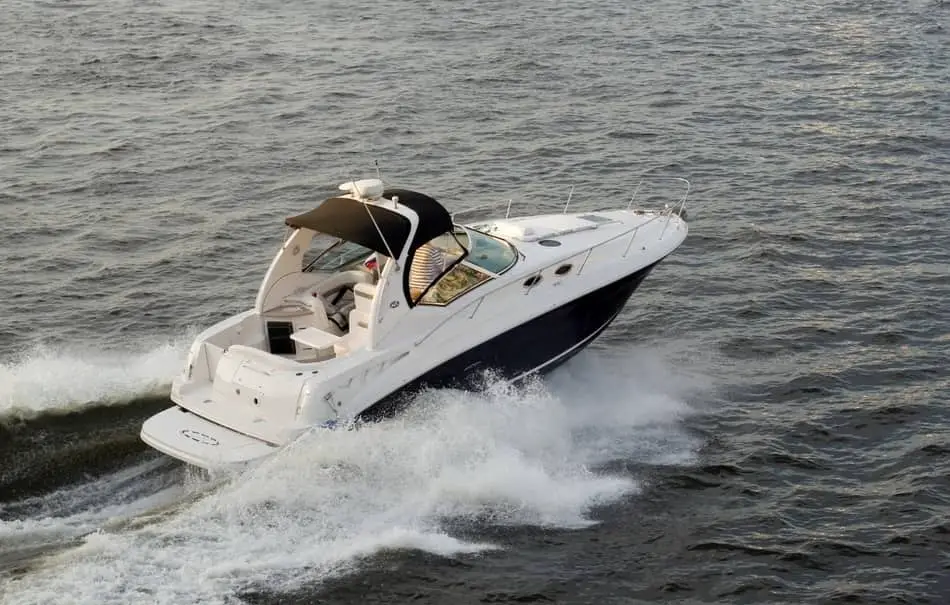
On average, a cabin cruiser boat can hold around 200 gallons of gas in its fuel tank. But the range can vary from 120 gallons or less for a small boat to 500 gallons or more for a big boat. Yet, most brands allow buyers to customize the boat to their needs, worrying less about fuel capacities.
Cabin cruiser boats are just like mobile mini homes that you can use to take the entire family on adventures. Even with small cabin cruisers, you have the flexibility to visit new ports, spend long weekends enjoying the boating lifestyle, or just kick back for a day of swimming and relaxing on the water.
Being bigger in size than most boats (including cuddy cabins), it burns more fuel. So cabin cruiser boats have bigger fuel capacities compared to pontoon boats, bass boats, cuddy cabins, etc. Here’s a table showing the fuel capacities of different cabin cruiser boat models.
A cabin cruiser becomes a small yacht if the size increases furthermore, accumulating more space on board. A cabin cruiser also has an area behind the cockpit that is open to the outdoors. This makes a great area for resting in the sun or for fishing, crabbing, and more.
A cabin cruiser will generally range anywhere from $100,000.00 to $500,000.00. Below $100,000, and you’re probably looking at a cuddy cabin and above $500,000.00, and you’re probably looking at a yacht or trawler. Go Downsize
How Many Gallons Of Gas Does A Cuddy Cabin Hold?
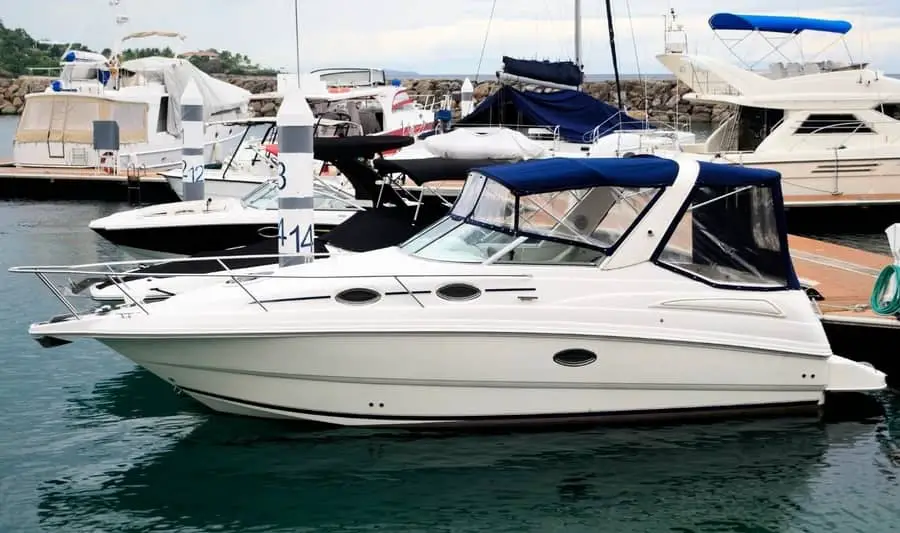
On average, a cuddy cabin boat can hold around 50 gallons of gas in its fuel tank. But the range can vary from 30 gallons or less for a small cuddy to 150 gallons or more for a big cuddy. Yet, most brands allow buyers to customize the boat to their needs, worrying less about fuel capacities.
Cuddy cabin boats offer day cruisers an interior space to sleep at night. These boats are often built like bowrider boats in the center and rear of the boat, but the front holds a cabin rather than a sitting area.
In fact, the average size of a cuddy cabin is between 18 and 28 feet long. Anything larger, and you’re probably dealing with a cabin cruiser rather than a cuddy cabin. Here’s a table showing the fuel capacities of different Cuddy Cabin boat models.
Cuddy cabin boats need a lot of fuel depending on the size and the usage. If you are cruising all day and want to sleep overnight, at least a 100-gallon tank is a must. Anything lower than that means you are at risk and should use the fuel accordingly.
Related post – Is Boat Fuel Expensive? Check this article to know more about the cost of the fuel that is used in boats and how they distinguish from normal gas station prices.
How Many Gallons Of Fuel Does A Yacht Hold?
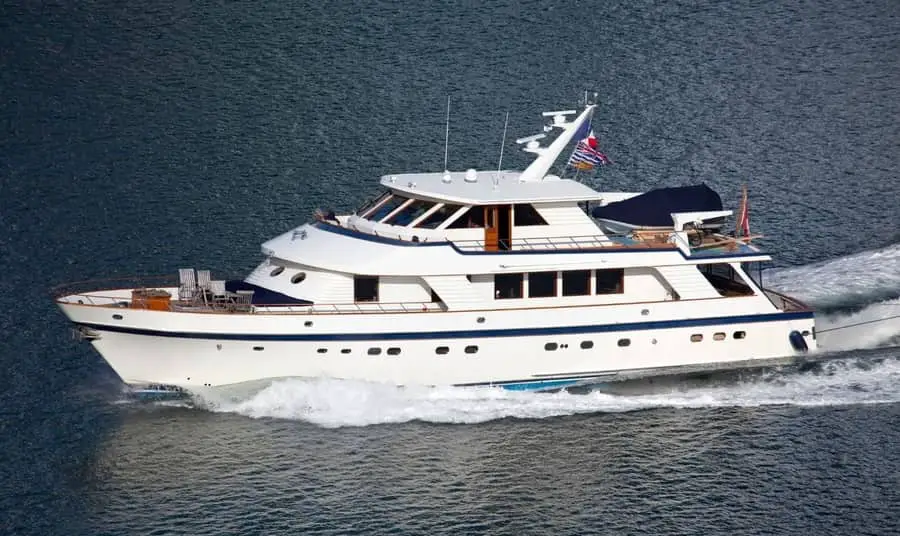
On average, a yacht can hold around 25,000 gallons of fuel in its fuel tank. But the range can vary from 1,000 gallons for a small yacht to 250,000 gallons or more for a big yacht. Yet, most brands allow buyers to customize the yacht accordingly, worrying less about fuel capacities.
A yacht is a larger recreational boat or ship. The word “Yacht” came from Dutch origin and was originally defined as a light and fast sailing vessel used by the Dutch navy to find and capture pirates. On the other hand, a boat is smaller in size and can be anything from a fisherman’s boat to a sailboat.
Yacht engines are much larger in size, can produce considerably more power – in some cases up to 800hp, and are capable of running much longer distances, requiring very bigger tanks. Here’s a table showing the fuel capacities of different yacht models.
Smaller yachts like motor yachts or motor sails can hold around 3,000ish gallons of fuel, while the larger ones have the capacity for up to 250,000 gallons. That could cost $875,000 to fill up the tank with an average fuel price of $3.50 per gallon. Imagine spending close to $1,000,000 to fill up the yacht.
According to Superyachts.com , a boat measuring more than 71 meters consumes a staggering 132 gallons of diesel an hour—and that’s only if the engine is on, but the boat isn’t moving. If you actually want to go anywhere, you will be spending over $2,440 an hour, based on cruising speeds of between 15 and 22 knots.
Lürssen’s M/Y Azzam currently holds the title of the largest superyacht in the world. That’s equivalent to refilling a typical hatchback car more than 23,800 times, and the same amount of fuel could fill up almost six Boeing 747 commercial airliners. Likewise, it would take the fuel of 3,636 London double-decker buses or 167 24-meter yachts to fill Azzam.
The Key Takeaways From The Post
A boat can hold around 40 gallons of gas in its tank on average. But the range can vary from 5 gallons or less for a small boat to 250,000 gallons or more for a big yacht. Yet, most brands allow buyers to customize the boat to their needs, worrying less about fuel capacities.
Boats are not as fuel-efficient as cars. They consume a lot of gas compared to other vehicles due to traversing in the waters. That’s one of the main reasons why most boats have bigger fuel capacities compared to other vehicles.
Many small boats tend to use 3-8 gallons of gas per hour at cruising speeds, while faster boats like speed and motorboats can use 25-40 gallons an hour.
Depending on the boat’s weight, size, model, and, very importantly, the type of motor it has, the fuel burning rate changes drastically.
My name is Mahidhar, and I am passionate about boating. Every day I learn some new things about boats and share them here on the site.
Recent Posts
How Much Does a Houseboat cost? 14 Examples (Various models)
Houseboats are wonderful for people who want to live on the water but don't want to pay for real estate. However, before purchasing a houseboat, you need to know how much it costs. On average,...
How Much Does a Bass Boat Cost? 15 Examples (Details included)
Navigating the boat market for “bass boats” can be daunting with such an array of design features, models, and brands. Bass boats are perfect for fishing. However, before purchasing a bass boat,...

Your Head Start Gift! Kickstart Your Explorer Yacht Journey By Understanding How To Work With Your Shipyard. FREE DOWNLOAD
- Jul 5, 2021
Yacht Fuel and Water Tank Capacities
Updated: Feb 10, 2023
The time has come for us to review fuel and water tank capacities on Vanguard. We were spurred by adding a unique need for Water/Glycol cooling systems required by the hybrid drive. So to kick this off, we looked at a few similar hulls to get a better feel for what the market is looking for:
1 – first off, we looked at other high L/B ratio hulls, specifically FPB78 and XPM78-01. These were both the same length but differed in their beam and internal layout, 3 and 2 cabin designs. (Design details for the Circa Marine 24M are not easy to find).
2 – then, we looked at another displacement hulls with three cabins and similar internal volume – Nordhavn 64 , single-engine, and Bering 65 twin-engine.

Explorer Yacht Tank Volumes
3 – we looked at semi-planing hulls of similar layout and internal volume. Twin-engine Fleming 65 and Ocean Reef . Table 1 below displays the results for fuel and water tank storage capacities across different yacht brands. What is immediately apparent is the installed power with FPB78 and XPM78 series being significantly lower for a similar speed profile to the two other displacement hulls of Nordhavn and Bering. Even more so for the semi-planing hulls. Conversely, FPB78 and XPM78 have significantly higher freshwater tank capacities. This capacity is partly as a ballast function (see fuel tank capacities) and party to reflect their passage-making profile where convenient marina facilities are far and long apart.
Grey and Black Water
Grey and blackwater tank capacities were a little harder to find. Greywater is easier to deal with and, in most cases, can be discharged overboard unless in environmentally sensitive areas and some freshwater lakes. Discharge may become more restrictive as the legislation progresses, so we decided to install these tanks for all shower and sink drains. We will probably lead HVAC drains overboard. Blackwater is subject to pump-out requirements at marina facilities or defined distance offshore, typically 3 miles. We split our tank capacity 50% Grey, 50% black. Greywater can overflow to black if necessary but not the other way around. Greywater tanks will be marine-grade aluminum hull tanks; black water will be polypropylene fabricated tanks to limit corrosion. Eight hundred liters capacity for each seems in line with the other 3-cabin yachts irrespective of hull design. We will create an interlock in the Helm Station mimic diagrams to prevent unwanted discharge in restricted waters and install remotely operated valves in the system.
Yacht Fuel Tanks
We looked at the fuel tanks. In considering these it is also necessary to consider installed power on each vessel. We estimated operational engine power as 60% of installed capacity except for the high L/B hulls where the second engine provides redundancy and is not power. At 60% power, we assume that the higher-powered hulls are not yet planing. Tanks on Vanguard are smaller than XPM78-01 with similar hydrodynamic power needs and FPB78 with a slightly wider hull. However, the range remains about 7000 NM with 20% reserve , and we do not feel the need to increase this. The one change we would like to see is a reduction in the volume of the day tanks. Three-day capacity is ample, and we would like to remove a little weight from the stern of the hull and add a little more space in the engine room.
Yacht Water Tanks
Then we looked at water storage tanks. Some of this capacity is designed as ballast compensation to keep trim as the fuel reduces. Vanguard will have an onboard water maker additional to any shore supply. We decided to retain the large water storage capacity, it adds redundancy should the water maker fail and we will need the ballast capacity to counterbalance the fuel tanks as they deplete.
Hybrid Drive Yacht Cooling System
Like many EV’s, our cooling will use ethylene glycol in a 50/50 mixture. That gives excellent heat transfer performance, low freeing temperatures, and corrosion protection for any metal it touches. Due to its toxicity, the imperative is to keep it isolated from any potable water tanks and systems that minimize accidental contamination risks. Water/Glycol system could cool the batteries, inverters, EV Motors, hybrid drive gearbox, and main gearbox. Engines themselves have antifreeze coolant systems that we will leave as supplied.

XPM78-02 – Vanguard Tank Storage Plan
Space exists in the engine room bilge between and aft of the engines. Three frames will allow for a cofferdam aft of the freshwater tanks. Seawater in contact with the bottom skin area of the tank will cool the contents and (less efficiently) internal air contact. Being set low in the hull, any systems not operating will drain to the sump tank removing toxic ethylene glycol from the lines when possible.
By eliminating seawater, we eliminate corrosion and fouling. We can also consider fitting third-party sealed plate coolers instead of traditional tube coolers with corresponding weight and size reductions. The engine cooling system can remain independent as there is a wet exhaust system installed so we cannot eliminate the seawater flow.
I’d be a little nervous about this idea if the systems were either high-powered or continuously running. Apart from the engines, the operation is periodic, in the order of 1 or 2 hours. For all systems, the cooling requirements are pretty modest, in the order of a few kW. We still need to undertake a heat balance for the system to double-check, but I think we are good (see later Blog). The fallback is to add a parasitic seawater cooler into the system, which we would rather avoid right now.
Conclusion for Fuel and Water Tank Capacities
So the final design has:
retained most fuel and water tank capacities and their effect on trim and stability.
class-leading fuel range at >7000miles @ 10kn
more potable water/ballast than you need to fill a small swimming pool
ample greywater, and blackwater capacity.
a nifty, passive water/glycol cooling system suitable for high latitude operation, removing most seawater systems from the engine room.
Items 1 through 4 came at no effort thanks to work already undertaken for hull number 1 Mobius. Item 5 is our add-on to that configuration.
Read also: Aluminium, Fibreglass, Steel or Wooden Hulls?
Read also: Explorer Yacht, Electrical System Design
- Building Vanguard
- Yacht Equipment
Recent Posts
New Props Fixed Our Shaft Vibration Problem.
Two Steps Forward, One Back
Continuing the Pursuit of Seaworthy!

Find anything, super fast.
- Destinations
- Documentaries
Flying Fox Specifications
- Name Flying Fox
- Model Custom
- Hull Colour -
- Naval Architect Lurssen Yachts
- Exterior Designer Espen Oeino
- Interior Designers Mark Berryman Sabrina Monte Carlo
- Length Overall 136.0m
- Length at Waterline -
- Draft (min) -
- Draft (max) 22.5m
- Gross Tonnage -
- Cabins Total 11
- Cabins 1 Master / 10 VIP
- Hull Configuration Displacement
- Hull Material Steel
- Superstructure -
- Deck Material -
- Fuel Type -
- Manufacturer -
- Total Power -
- Propulsion -
- Max Speed -
- Cruising Speed 15 Kn
- Fuel Capacity -
- Water Capacity -
- Generator -
- Stabilizers -
- Thrusters -
- Amenities -
- Yacht Builder Lurssen Yachts View profile
- Naval Architect Lurssen Yachts View profile
- Exterior Designer Espen Oeino View profile
Yacht Specs
Other lurssen yachts, related news.
Please use a modern browser to view this website. Some elements might not work as expected when using Internet Explorer.
- Landing Page
- Luxury Yacht Vacation Types
- Corporate Yacht Charter
- Tailor Made Vacations
- Luxury Exploration Vacations
- View All 3617
- Motor Yachts
- Sailing Yachts
- Classic Yachts
- Catamaran Yachts
- Filter By Destination
- More Filters
- Latest Reviews
- Charter Special Offers
- Destination Guides
- Inspiration & Features
- Mediterranean Charter Yachts
- France Charter Yachts
- Italy Charter Yachts
- Croatia Charter Yachts
- Greece Charter Yachts
- Turkey Charter Yachts
- Bahamas Charter Yachts
- Caribbean Charter Yachts
- Australia Charter Yachts
- Thailand Charter Yachts
- Dubai Charter Yachts
- Destination News
- New To Fleet
- Charter Fleet Updates
- Special Offers
- Industry News
- Yacht Shows
- Corporate Charter
- Finding a Yacht Broker
- Charter Preferences
- Questions & Answers
- Add my yacht
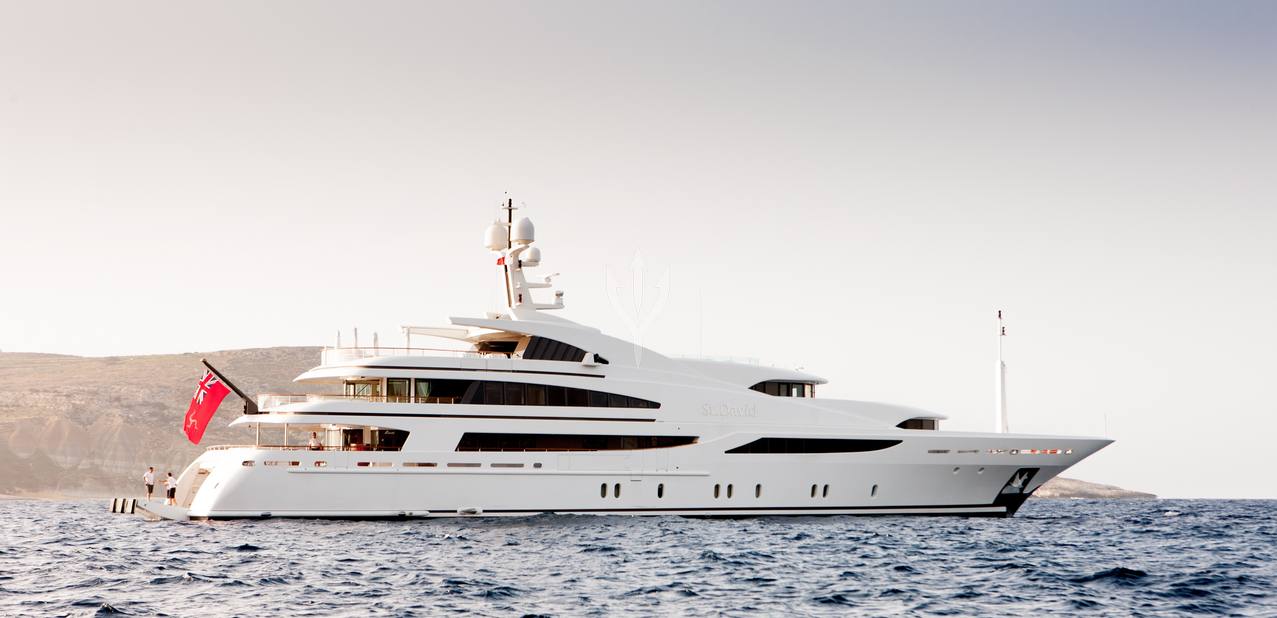
View More Photos
- Luxury Charter Yachts
- Motor Yachts for Charter
St David (ex: Xanadu)
- Amenities & Toys
- Rates & Regions
- + Shortlist
ST DAVID YACHT CHARTER
60m / 196'10 benetti 2008 / 2019.
- Previous Yacht
Cabin Configuration
- 5 Double/Twin
Special Features:
- Split-level Master Suite Offers Panoramic Views
- Baroque Style with Mosaic Floors
- Outdoor Cinema & Private Nightclub
- Spa & Massage Facilities
- Flexible Accommodation
Superyacht St David promises to deliver an outstanding charter vacation
The 60m/196'10" 'St David' (ex. Xanadu) motor yacht built by the Italian shipyard Benetti is available for charter for up to 12 guests in 6 cabins. This yacht features interior styling by British designer Winch Design.
Built in 2008, St David boasts a multitude of decks ideal for relaxation and entertainment indoors or outdoors, ensuring guests will live la dolce vita on the open waters. She is equipped with a dancefloor, spa and gym.
Guest Accommodation
St David offers guest accommodation for up to 12 guests in 6 suites comprising a master suite and five cabins that can operate as twins or doubles. The bed configuration includes 1 king, 1 queen and 4 doubles. She is also capable of carrying up to 14 crew onboard to ensure a relaxed luxury yacht charter experience.
Onboard Comfort & Entertainment
A charter on St David is comfortable and convenient thanks to the provided amenities, notably a dancefloor where you and your guests can celebrate in style. Take the opportunity to be thoroughly pampered and indulged in the spa plus maintain your fitness routine and work out in the well-equipped gym. Retreat to the deck jacuzzi and soak up the scenery.
St David benefits from some excellent features to improve your charter, notably Wi-Fi connectivity, allowing you to stay connected at all times, should you wish. Guests will experience complete comfort while chartering thanks to air conditioning.
Performance & Range
Built with a steel hull and aluminium superstructure, she offers greater on-board space and is more stable when at anchor thanks to her full-displacement hull. Powered by twin Caterpillar engines, she comfortably cruises at 13 knots, reaches a maximum speed of 17 knots with a range of up to 5,500 nautical miles from her 116,000 litre fuel tanks at 12 knots. An advanced stabilisation system on board reduces the side-to-side roll of the yacht and promises guests exceptional comfort levels at anchor or when underway.
St David knows a thing or two about fun on the water, with an extensive selection of action packed water toys and accessories for you and your guests to enjoy whilst on charter. You'll be loving the huge adrenaline rush as you zip over the water on a Yamaha GP 1300 WaveRunner. Also there are waterskis that are hugely entertaining whether you are a beginner or a seasoned pro. Additionally, there are two Cayago F7 SEABOBs, offering a truly remarkable experience that lets you skim along the surface or swim with the fishes quietly and safely. If that isn't enough St David also features wakeboards, kayaks, fishing equipment, scuba diving equipment and inflatable water toys. St David features two tenders, but leading the pack is a 7.5m/24'7" Tresco Limo Tender to transport you in style.
St David and her crew are available for charter this summer for cruising within the Mediterranean. She is already accepting bookings this winter for cruising in Bermuda and the Caribbean.
With a highly experienced and talented crew of 14, you can be sure that each and every need will be met and exceeded while on board this prestigious motor yacht.
TESTIMONIALS
There are currently no testimonials for St David, please provide .
St David Photos
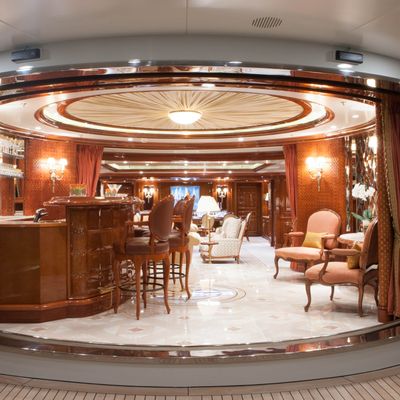
Amenities & Entertainment
For your relaxation and entertainment St David has the following facilities, for more details please speak to your yacht charter broker.
St David is reported to be available to Charter with the following recreation facilities:
- 1 x 7.5m / 24'7 Tresco Custom Limo Tender Volvo and Rolls Royce 300 HP engine
- 1 x 4.7m / 15'5 Ribline Custom RIB
For a full list of all available amenities & entertainment facilities, or price to hire additional equipment please contact your broker.
St David Awards & Nominations
- The World Superyacht Awards 2009 Best Displacement Motor Yacht of 500GT to 1,299GT (approximately 50m – 59m) Finalist
- + shortlist
For a full list of all available amenities & entertainment facilities, or price to hire additional equipment please contact your broker.
APPROVED RYA WATER SPORTS CENTRE
Your family and friends could learn to use the water toys on your charter vacation onboard this luxury charter yacht. Motor Yacht St David is a certified RYA Training Centre yacht.
'St David' Charter Rates & Destinations
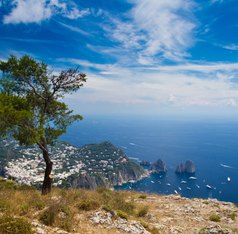
Summer Season
May - September
€325,000 p/week + expenses Approx $353,000
High Season
€345,000 p/week + expenses Approx $374,500
Cruising Regions
Mediterranean Croatia, France, Greece, Italy, Monaco, Montenegro
HOT SPOTS: Amalfi Coast, Corsica, French Riviera, Mykonos, Sardinia
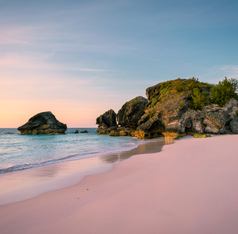
Winter Season
October - April
$325,000 p/week + expenses
$345,000 p/week + expenses
Bermuda Caribbean Antigua, Bahamas, Cuba, Saint Martin, St Barts Central America Costa Rica
HOT SPOTS: Virgin Islands
Charter St David
To charter this luxury yacht contact your charter broker , or we can help you.
To charter this luxury yacht contact your charter broker or
On Board Review
After spending time on board the 60m/197ft superyacht ‘St David’ at the Antigua Charter Yacht Show, YachtCharterFleet finds out if she fulfils her ambitious brief to be the perfect charter yacht.
Whatever the occasion, St DAVID offers the ultimate in luxury escapism
Read Review

Update your yacht
Yacht Owner, Captain or Central Agents - Send us latest Photos, Charter Rates or Corrections Send Updates
SIMILAR YACHTS FOR CHARTER
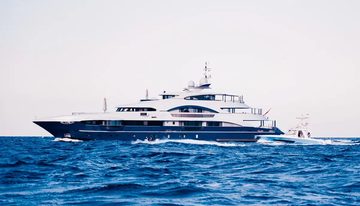
55m | Heesen
from $350,000 p/week

66m | Oceanco
from $489,000 p/week ♦︎
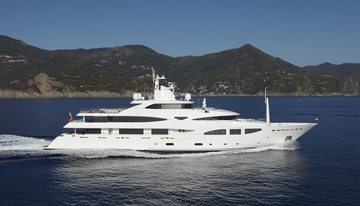
from $378,000 p/week

59m | Benetti
from $395,000 p/week
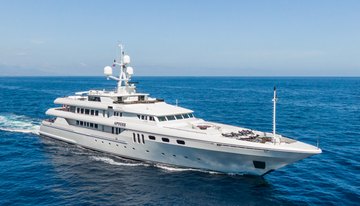
63m | Codecasa
from $360,000 p/week

61m | Abeking & Rasmussen
from $646,000 p/week ♦︎

58m | Turquoise Yachts
from $350,000 p/week ♦︎ *
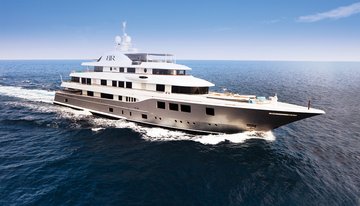
Baton Rouge
63m | Icon Yachts
from $456,000 p/week ♦︎
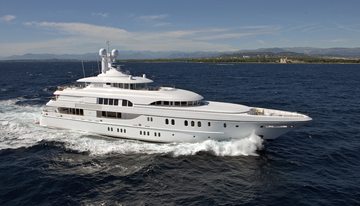
60m | Lurssen
from $550,000 p/week
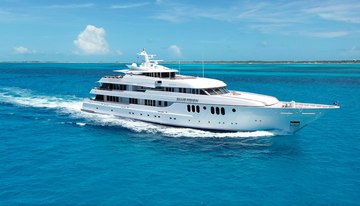
60m | Feadship
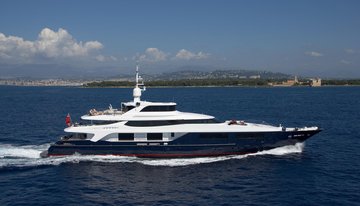
54m | Baglietto
from $245,000 p/week
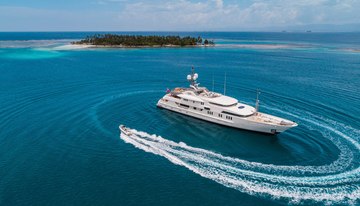
62m | Amels
from $345,000 p/week
NOTE to U.S. Customs & Border Protection
Specification
SEASONAL CHARTER RATES
- Share on Facebook
- Share Yacht
SIMILAR LUXURY CHARTER YACHTS
Here are a selection of yachts which are similar to the current charter yacht. To view all similar luxury charter yachts click on the button below.
As Featured In
The YachtCharterFleet Difference
YachtCharterFleet makes it easy to find the yacht charter vacation that is right for you. We combine thousands of yacht listings with local destination information, sample itineraries and experiences to deliver the world's most comprehensive yacht charter website.
San Francisco
- Like us on Facebook
- Follow us on Twitter
- Follow us on Instagram
- Find us on LinkedIn
- Add My Yacht
- Affiliates & Partners
Popular Destinations & Events
- St Tropez Yacht Charter
- Monaco Yacht Charter
- St Barts Yacht Charter
- Greece Yacht Charter
- Mykonos Yacht Charter
- Caribbean Yacht Charter
Featured Charter Yachts
- Maltese Falcon Yacht Charter
- Wheels Yacht Charter
- Victorious Yacht Charter
- Andrea Yacht Charter
- Titania Yacht Charter
- Ahpo Yacht Charter
Receive our latest offers, trends and stories direct to your inbox.
Please enter a valid e-mail.
Thanks for subscribing.
Search for Yachts, Destinations, Events, News... everything related to Luxury Yachts for Charter.
Yachts in your shortlist

EXCELLENCE YACHT SPECS
More About EXCELLENCE
Summary of the EXCELLENCE Yacht Specs
For the complete EXCELLENCE yacht specs in table view see below. Built by luxury yacht builder Richmond , the luxury motoryacht EXCELLENCE measures in at 150ft / 45.7m. She has a beam of 28, and a draft of 7.4, and she measures in at 441 gross tons. She sleeps up to 12 guests in 6 staterooms and has accommodations for 8 crew. She is propelled by MTU engines at 2,000 hp each with a maximum speed of 18 knots and a cruising speed of 14 knots. Her decks are Teak and hull is Fiberglass. Exterior styling is by Ward Setzer with her interior design by Pavlik Yacht Design .
Page Contents
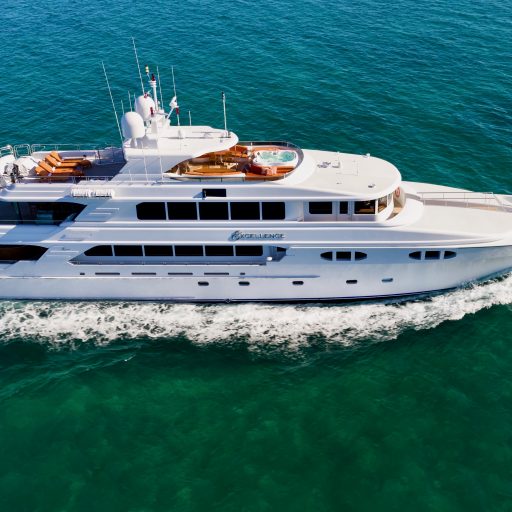
Download PDF Brochure ,

Download PDF Brochure
Contact: Merle Wood & Associates | web(Contact us at)merlewood.com | +1.954.525.5111
† US Duty Paid
Short Specification
441 GROSS TONS
Richmond | 2010
150 ft / 45.7 m, 28 ft / 8.5 m, 7.4 ft / 2.3 m, detailed excellence yacht specs, hull & dimensions, guests & crew, performance.
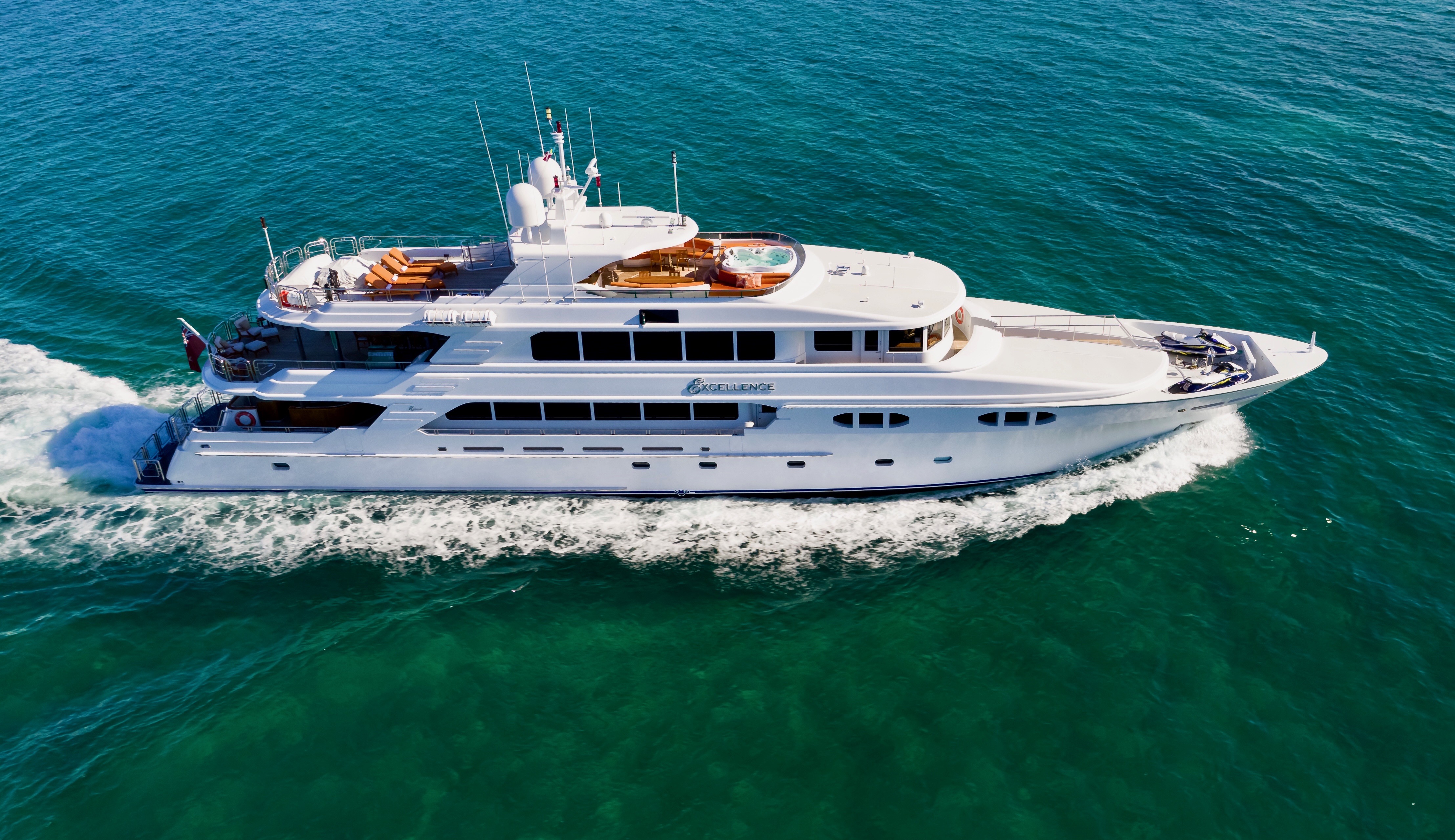
Overview Of EXCELLENCE Yacht Specs
441 Gross Tons
19% of Length
5% of Length
Interested In The EXCELLENCE Yacht?

EXCELLENCE YACHT INFO

EXCELLENCE YACHT PRICE

EXCELLENCE YACHT PHOTOS

EXCELLENCE YACHT LOCATION
For additional information, the price, photos and location, select one of the options above. Here you will find more detailed information about the EXCELLENCE yacht. For more information on the EXCELLENCE yacht specs, scroll down.
About The EXCELLENCE Yacht Specs
For more information on the EXCELLENCE yacht specs or your own custom yacht report , simply contact a yacht broker at Merle Wood & Associates. As an internationally recognized leader in the sales, marketing and chartering of the most discerning yachts world-wide, we are dedicated to enhancing the yachting lifestyle and enjoyment of all our clients.
- 1-954-525-5111
- web(Contact us at)merlewood.com
- About us
I'm interested in:
Chartering a yacht Buying a yacht Selling a yacht Charter marketing Building a yacht Other
Please leave this field empty.
More Yachts For Sale & For Charter
EXCELLENCE Yacht Specs and Updates
The EXCELLENCE yacht specs have been compiled and sorted to provide our visitors the most current and accurate data for the luxury yacht EXCELLENCE. If you would like to report an error or submit additional specifications about the EXCELLENCE yacht , please contact our luxury yacht intelligence team .
At Merle Wood & Associates, we focus on providing the best user experience throughout our website for our visitors. We achieve this by using cookies, which store a little information from your browser. If you would like to learn more, please see our privacy and cookies policy .
Share this page

- Yacht Search
- Charter a Yacht
- Buy A Yacht
- Build a Yacht
- Sell a Yacht

Your Name (required)
Your Message
Please call me Please email me
Your Phone (required)
CANCEL Please leave this field empty.

Boat Fuel Tank Size Calculator
Here’s an example table for boat fuel tank sizes. Please note that this is a general reference, and actual fuel tank sizes can vary depending on the specific boat model and manufacturer.
Again, these figures are approximate and can vary depending on the specific boat model, design, and manufacturer. It’s essential to consult the boat’s specifications or contact the manufacturer for accurate information on the fuel tank size for a particular boat model.
How do you calculate fuel tank capacity?
To calculate fuel tank capacity, you need to consider the following information:
- Usage : Determine the expected fuel consumption rate of your boat’s engine in gallons per hour . This information can often be found in the engine’s specifications or user manual.
- Range : Estimate the maximum distance you plan to travel in nautical miles during a typical trip.
The calculation for fuel tank capacity is as follows:
Fuel Tank Capacity (in gallons) = Fuel Consumption Rate (in gallons per hour) × Maximum Travel Distance (in nautical miles)
For example, if your boat’s engine has a fuel consumption rate of 5 gallons per hour and you plan to travel up to 100 nautical miles, the fuel tank capacity calculation would be:
Fuel Tank Capacity = 5 gallons/hour × 100 nautical miles = 500 gallons
Keep in mind that this calculation assumes continuous operation for the entire travel distance. Adjustments may be necessary to account for factors such as reserve fuel, efficiency variations, and safety margins.
It’s important to consult your boat’s engine specifications, manufacturer recommendations, and any relevant regulations or standards to ensure proper fuel tank capacity for your specific vessel.
How do you calculate fuel for a boat trip?
To calculate fuel for a boat trip, multiply the boat’s fuel consumption rate (gallons per hour) by the estimated trip duration (in hours). For example, if the boat consumes 8 gallons per hour and the trip lasts 5 hours, the fuel required would be 40 gallons.
To calculate the fuel required for a boat trip, you need to consider the following factors:
- Distance : Determine the distance you plan to travel for the trip. This can be measured in nautical miles or any other applicable unit.
- Fuel Consumption Rate : Determine the fuel consumption rate of your boat’s engine. This information is typically provided in gallons per hour (GPH) or liters per hour (LPH) and can be found in the engine’s specifications or user manual.
- Duration : Estimate the duration of the trip in hours. If you don’t have an exact duration, you can estimate based on the speed and expected time to reach your destination.
The calculation for fuel required for the boat trip is as follows:
Fuel Required (in gallons) = Fuel Consumption Rate (in gallons per hour) × Duration (in hours)
For example, if your boat’s engine has a fuel consumption rate of 8 gallons per hour and you estimate that the trip will take 5 hours, the fuel required calculation would be:
Fuel Required = 8 gallons/hour × 5 hours = 40 gallons
It’s important to note that this calculation assumes a constant fuel consumption rate throughout the trip. Actual fuel consumption may vary based on factors such as boat speed, sea conditions, wind, and other variables. It’s recommended to consider safety margins and potential contingencies when calculating fuel requirements.
Always consult your boat’s engine specifications, manufacturer recommendations, and any applicable regulations or standards for accurate fuel consumption information and safety guidelines specific to your vessel.
How much fuel does a boat hold?
The fuel capacity of a boat can vary significantly depending on the size, type, and design of the vessel. Boat fuel tanks are available in various sizes and configurations to suit different boat types and purposes.
Small recreational boats, such as those used for fishing or day trips, may have fuel capacities ranging from 10 to 100 gallons.
Mid-sized boats, including cruisers or small yachts, typically have fuel capacities ranging from 100 to 500 gallons.
Larger vessels, such as commercial ships or luxury yachts, can have fuel capacities ranging from several hundred to thousands of gallons.
It’s important to note that the fuel capacity of a boat is determined by its design and the available space for fuel storage. The actual fuel capacity will be specified by the boat manufacturer or can be found in the boat’s specifications, documentation, or owner’s manual.
What is the average mpg for a boat?
The average miles per gallon (MPG) for a boat can vary significantly depending on various factors, such as the type of boat, engine efficiency, hull design, boat speed, load, and sea conditions. It’s challenging to provide a specific average MPG value that applies to all boats universally.
However, here are some general estimates for different types of boats:
- Recreational Powerboats : On average, recreational powerboats can achieve around 2 to 8 miles per gallon, depending on factors such as boat size, engine type, and cruising speed. Smaller boats with efficient engines may achieve higher MPG values, while larger boats or those with high-performance engines may have lower MPG.
- Sailboats : Sailboats primarily rely on wind power, and their fuel consumption is typically lower than powerboats. However, sailboats may still have auxiliary engines for propulsion and maneuvering in certain conditions. The fuel consumption and MPG for sailboats depend on the size of the auxiliary engine and the usage of motorized propulsion.
- Personal Watercraft (Jet Skis) : Personal watercraft, such as jet skis, tend to have higher fuel consumption due to their high-performance engines. On average, jet skis may achieve around 2 to 5 miles per gallon.
It’s important to note that these figures are general estimates, and the actual MPG will vary based on individual boat characteristics, engine efficiency, operating conditions, and the way the boat is operated. Monitoring and optimizing your boat’s fuel consumption through efficient boating practices can help improve fuel efficiency and reduce fuel consumption.
How much fuel does a 40 foot boat use?
The fuel consumption of a 40-foot boat can vary depending on several factors, such as the type of boat, the engine(s) installed, cruising speed, sea conditions, and load. It is challenging to provide an exact fuel consumption value without specific details.
However, as a rough estimate, a 40-foot boat with a single gasoline-powered engine might consume around 20 to 40 gallons per hour at cruising speed. This estimate can vary based on the boat’s weight, hull design, engine efficiency, and other variables.
For a 40-foot boat equipped with diesel engines, the fuel consumption may be lower, typically ranging from 10 to 30 gallons per hour at cruising speed.
It’s important to note that these figures are rough estimates and can vary significantly depending on the specific boat model, engine specifications, and operating conditions. Consulting the boat’s manufacturer, engine specifications, and owner’s manual will provide more accurate information regarding the fuel consumption for your particular boat model.
How much fuel does a 20 foot boat use?
The fuel consumption of a 20-foot boat can vary depending on several factors, including the type of boat, engine specifications, cruising speed, sea conditions, and load. Here is a rough estimate of fuel consumption for a 20-foot boat:
- Outboard Motor : If the 20-foot boat is powered by an outboard motor, fuel consumption can range from 3 to 8 gallons per hour at cruising speed. Smaller, more efficient engines tend to have lower fuel consumption, while larger or high-performance engines may consume more fuel.
- Inboard/Outboard (Sterndrive) : If the boat is equipped with an inboard/outboard (sterndrive) engine, fuel consumption can range from 4 to 10 gallons per hour at cruising speed.
- Inboard Motor : For boats with an inboard motor, fuel consumption can range from 4 to 8 gallons per hour at cruising speed.
It’s important to note that these figures are rough estimates and can vary based on factors such as the boat’s weight, hull design, engine efficiency, and operating conditions. The actual fuel consumption of a 20-foot boat can be obtained by referring to the specific engine manufacturer’s specifications, the boat’s owner’s manual, or consulting with the boat manufacturer or a qualified dealer for more accurate information.
Is 100 hours on a boat a lot?
The number of hours considered “a lot” for a boat depends on several factors, including the type of boat, its age, maintenance history, and usage patterns. Here are some general guidelines:
- Recreational Boats : For most recreational boats, 100 engine hours are not considered excessively high. It is common for boat owners to accumulate several hundred or even thousands of hours on their engines over the lifespan of the boat.
- Commercial Boats : Commercial boats, such as charter fishing vessels or water taxis, often accumulate significantly higher engine hours. These boats may frequently operate for long hours, and it is not uncommon for them to have thousands of engine hours within a relatively short period.
- Age and Maintenance : It is essential to consider the boat’s age and the maintenance history when assessing engine hours. A well-maintained boat with 100 hours on the engine could be in better condition than a poorly maintained boat with fewer hours.
- Engine Type : Different engine types have varying lifespan expectations. Gasoline engines generally have shorter lifespans compared to diesel engines. Diesel engines, with proper maintenance, can often last longer and handle higher engine hours.
Ultimately, it is best to consider engine hours in conjunction with other factors, such as overall condition, maintenance records, and any signs of wear or problems. If you are purchasing a used boat, a thorough inspection by a qualified marine mechanic can provide a better understanding of its condition, regardless of the number of engine hours.

GEG Calculators is a comprehensive online platform that offers a wide range of calculators to cater to various needs. With over 300 calculators covering finance, health, science, mathematics, and more, GEG Calculators provides users with accurate and convenient tools for everyday calculations. The website’s user-friendly interface ensures easy navigation and accessibility, making it suitable for people from all walks of life. Whether it’s financial planning, health assessments, or educational purposes, GEG Calculators has a calculator to suit every requirement. With its reliable and up-to-date calculations, GEG Calculators has become a go-to resource for individuals, professionals, and students seeking quick and precise results for their calculations.
Related posts:
- Boat Fuel Cost Calculator
- Boat Fuel Burn Calculator
Leave a Comment Cancel reply
Save my name, email, and website in this browser for the next time I comment.

How Far Can Yachts Travel? Helpful Examples (With Numbers)
There are several things to consider when asking the question: “How far can a yacht journey?”
There are many different variables, including the type of yacht, the size of the fuel tank(s), the weather, and the amount of crew/gear aboard.
Not to mention the skill and experience of the captain.
How Far Can A Yacht Travel?
Generally, a motorized yacht about 35 feet in length can travel around 200 miles at approximately 25 knots in an 8 hour day. At 35 knots, they can travel close to 300 miles in a day. With enough fuel or fill-ups, you can go on for thousands of miles.
With the addition of sails, a yacht can travel even further, but it takes longer.
Here’s everything you need to know!
Table of Contents

How Far Does the Average Yacht Travel?
This question is difficult to answer on its own.
However, on average, a 75-foot motorized yacht with a tank that can carry 11,000 liters of fuel can travel up to 1500 nautical miles.
If you are comparing your yacht to this average, make sure also to compare your tank size.
For example:
- A 95-foot yacht with a 9000-liter fuel tank can travel up to 1,200 nautical miles.
- A 40-foot yacht with a 5,000-liter fuel tank can travel up to 3,000 nautical miles.
Think of it this way: the bigger the boat, the bigger the fuel compartment.
The bigger the fuel tank (for the size of the boat,) the farther it can travel.
Other variables can affect those numbers, but these are the main factors you need to consider.
We have an article here with much more statistics and numbers on boating .
How Big is the Fuel Tank on a Yacht?
Different yachts have different-sized gas tanks on board.
The size of the fuel tank has a lot to do with how far it can travel.
After all, no fuel = no travel, right?
Not necessarily.
For a motorized yacht, there are really only two things to consider when trying to determine the distance it can travel:
- The amount of fuel you have (or how big the tank is)
- How much of it is burned by the engines (which is affected by different factors)
Side note: generally speaking, it is a good idea to have about one and a half times the amount of fuel you will need for the trip you want to make.
Different weather conditions can affect how slow your trip is, as well. Yachts are slower in rough weather. If there are bad weather conditions, yachts won’t be able to travel as far. On the opposite side, a yacht can travel much further in optimum weather conditions, when the engines don’t have to fight against the wind and choppy waters.
On the other hand, sailing boats are powered by the winds on the sea.
Weather can be finicky, and, because of that, most sailing yachts have an alternative form of power.
Some of those include:
- Auxiliary engines, usually diesel-powered
- Wind generators or solar panels
- Diesel generators
Remember to read up on international flag rules for boats before leaving.
How Far Can a Yacht Journey with a Full Fuel Tank?
Even superyachts come in different sizes and with different sized fuel tanks.
However, let’s say that you’re on a 130-foot yacht with a fuel tank of 22,420 liters.
If the yacht is cruising at around 20 knots, it can travel about 1500 nautical miles on that fuel tank.
To find how far you can go on one tank of fuel, you will have to:
- Clean your boat and ensure that everything is working properly (an unmaintained yacht uses more fuel per nautical mile)
- Refuel your boat and log your engine hours and start/stop times to find your fuel burn rate.
- Remember, it is important to measure your liters or gallons per hour of use instead of only using your fuel gauge (which might not be accurate over the full scale).
The fuel burn rate calculation is = fuel used / hours, resulting in liters or gallons per hour. The calculation for fuel efficiency is distance/fuel used, resulting in miles per gallon or liters.
The fuel burn rate and fuel efficiency (fuel mileage) are different at different speeds. If both are calculated at the vessel’s standard cruising speed, the fuel efficiency is the cruising speed divided by the fuel burn rate.
For example, a yacht cruising at 10 knots burning 2.5 gallons per hour has a fuel efficiency of 4 nautical miles per gallon (10 / 2.5).
How Many Days Can you Sail For?
Depending on the vessel, you can sail anywhere from one day (on a small sailing yacht ) to a month, and some boats have sailed around the world without stopping.
You must account for:
- The number of people on your crew,
- what supplies you have on board,
- if you count for the times you dock for supplies or not, and
- the seaworthiness of your yacht
A 30-foot sailing yacht can carry enough supplies for someone to stay aboard for 90 days (or even longer).
There is a nonstop ocean sailing yacht race where some of the participants stay on their yachts from 110 to 160 days! Some even sail for 200 days!
You can also apply for jobs on boats to travel that far.
Can a Yacht Cross the Pacific Ocean?
Cruising around the world is a big dream for several yacht enthusiasts.
Being able to leave their day-to-day lives and do an amazing adventure like “boating around the world” is a legacy you can leave with your family.
Generally speaking, it takes about 10 – 12 days to cross the Pacific Ocean on a large yacht.
However, not all yachts are capable of making the trip.
The following summary describes the capabilities of the four yacht design categories used in the EU and UK:
Category D Yachts:
Category D yachts are rated for sheltered coasts and inland boating.
This means you can use them in lakes, protected harbors, and rivers. They would be fine as long as the waves don’t reach 4 feet in height as a rule.
However, these boats wouldn’t be able to make the cross-ocean trip.
Category C Yachts:
Category C yachts are used inshore.
Inshore means that you can go away from the protected harbors for some distance, but these boats still can’t handle waves that reach up to 8 feet in height.
So, while they can move safely around large lakes and bays, they still wouldn’t be able to make the cross-ocean trip.
Category B Yachts:
Category B yachts are used offshore and can handle waves that reach up to 13 feet in height and strong winds.
However, you still wouldn’t want to take a category B yacht on the cross-ocean trip because it isn’t self-sustaining.
At least, not for the time it takes to cross the Pacific Ocean. Besides, it wouldn’t do well in rough weather.
Category A Yachts:
Category A yachts can handle waves up to 23 feet in height and wind over 47 knots.
They are also designed to be self-sustainable for long voyages.
In other words, they are explorer’s vessels.
Can a Yacht Cross the Atlantic Ocean?

To cross the Atlantic, an average motorized yacht would need a tank with a capacity of about 5000 liters of fuel at a fuel efficiency of 2.5 nautical miles per gallon.
This would be for a fuel use rate of 4 gallons per hour at 10 knots cruising speed. This is at cruising speed, of course. hey can’t be traveling at maximum speed for long periods of time (which would burn through the fuel faster).
At 10 knots, the trip (about 3,000 miles) would take 300 hours or 12.5 days.
Sailing yachts travel the Atlantic every year since the only fuel they need is for generators that power onboard appliances.
Though, some fuel may be used to power the boat when the weather isn’t cooperating.
It takes about 4 – 5 days to cross the Atlantic Ocean on a fast yacht going 25 knots . However, it would take longer in a sailing yacht (which also depends on the winds).
We have much more info on what you need to know about which yacht types can cross oceans. It’s a must-read if you are considering a trip over the bigger oceans on a yacht.
What is a Long-Range Expedition Yacht?
Long-range expedition yachts are yachts that are self-sustaining.
They are also built with long voyages in mind.
They normally feature:
- Adequate crew capacities, amenities, and storage
- Have a long cruising range, meaning large capacity fuel and water tanks
- Have a robust hull for the long trip
They have to withstand extreme weather conditions since they have to travel across large water bodies. They should be able to withstand the effects of sailing thousands of miles of traveling a year.
They must be easy to maintain and operate. This is due to the distance they must travel. After all, these yachts are often operated by a few laymen boaters (in addition to having a few experienced sailors with them).
Fishing trawlers (designed for many days at sea with cabins) are hearty and can travel the same distance (within range of their fuel tanks) as an expedition yacht but are typically not finished as a yacht.
They also have the appearance of a hearty, military-style craft with tall bows, broken sheers, and vertical or forward raking windshields.
If painted naval gray, they definitely fit the aesthetic of a military-grade vessel. But the reason for all of those features is because both expedition yachts and military vessels move long distances for extended periods of time.
Final Thoughts:
The distance that a yacht can travel depends on the size of the fuel tank(s) and the fuel use rate.
A yacht with a large fuel tank or a sailing yacht (which only requires the wind and carries fuel for onboard generators) can travel much further than a small day cruiser yacht.
If you want to take a long voyage, make sure to take the right precautions first. When crossing either the Pacific or the Atlantic Ocean , you must make sure your boat is a category A yacht (or an expedition yacht). You must also ensure that your crew is experienced in crossing the ocean.
If you are on a yacht, it is never recommended to cross the ocean by yourself. While you may handle a smaller boat in waters closer to the shore, there is quite a bit of difference in a large yacht—especially when you are far from land.
You’ll also have to make sure you upgrade some amenities. Your water maker, power generation system, autopilot, and your freezer, just to name a few, are some of the systems which need to be in peak condition when making that long voyage.
In the end, the differences between having a boat that travels a short distance and a long one are:
- Made for Distance, and
- Well-Maintained
Click to share...

Boating Basics Online is reader-supported. When you buy via our links, we may earn a commission at no cost to you. Learn more
How to Find Out Your Boat Gas Tank Size Without the Boat Manual
Written by J. Harvey / Fact checked by S. Numbers
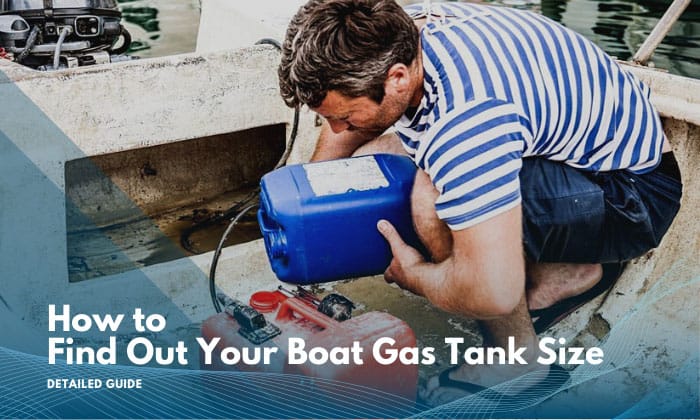
Knowing your fuel tank size is necessary to fill it with the right amount. In case of a spill, it’s not just about wasting fuel; there is also the matter of exposing ourselves to unnecessary danger. Fortunately, it’s easy to learn how to find out your boat gas tank size.
Referring to your boat manual or placard on the tank is the easiest way, but there are other methods if these are unavailable. Let’s cover a couple of them below.
Keep reading to learn more.
Table of Contents
What you’ll need:
How Many Gallons of Gas Does a Boat Hold on Average?
Frequently asked questions, ways to find out your boat gas tank size.
How Big is My Gas Tank? Two Ways to Find Out
The easiest way to find out how much fuel your tank can hold is to check the vessel’s owner manual for information. If you don’t have one on hand, you can also check the fuel tank, which may have that information printed somewhere on its body.
However, there may be instances where this information is unavailable, and you must determine the figure yourself. There are a couple of ways you can get it.
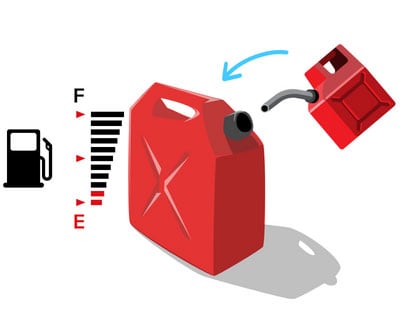
- Fuel source
- Fuel containers with known measurement
- Wiping cloth
- Hose (any kind)
This is a straightforward method. Since it does not involve complicated calculations like the second approach, it may be easier to rely on. However, this solution requires a lot of work.
Step 1: Empty the fuel tank
There are two ways to empty the tank. One way is to drain the contents out, but this may require some technical knowledge or specialized tools, so we’ll leave this discussion for another time.
The second method is something any boater can do on their own; operate the boat until it runs out of juice. It is important to plan your location, as you do not want to end up stranded far from land or the dock.
Step 2: Refuel using containers of known measurement
Fill up your containers with fuel; be sure to use ones with known measurements. Pour the gas into the tank one container at a time until it fills up. Take care not to spill any fuel for better accuracy.
Alternatively, use a hose to siphon the fuel into the tank to ensure there’s no spillage. Here’s how you do it:
- Insert one end of the hose into the tank, then insert the other end into your container. Ensure that the hose reaches the bottom of your container, which should be placed higher than the boat’s tank.
- Seal up any openings of the container to keep air from getting in; you can use pieces of cloth for this and just hold it in place by hand. The gas will flow out of the container and into the boat tank once the air is kept out.
- There may be a bit of fuel left, and you can just pour it yourself. Repeat as needed.
Step 3: Tally the gas consumed
Count the containers you need to fill the boat; subtract how much is left in the last container, if any. Add the total, and this is your boat’s fuel tank size.
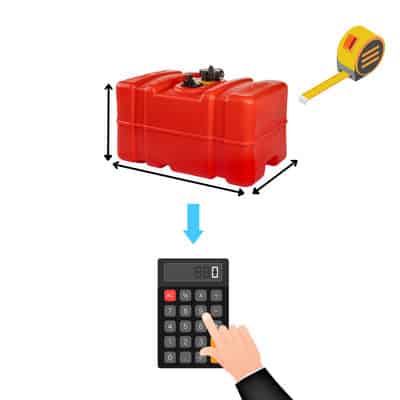
- Calculator (online or manual)
- Measuring tape
Using this method requires you to have access to your gas tank. This way requires less time to do but needs to factor in the tank’s shape, with irregularly designed tanks being more troublesome to compute.
Step 1: Take your gas tank measurements
Take the fuel tank’s measurements as accurately as possible. Rectangular tanks will need their length, width, and height. Meanwhile, cylindrical ones make use of the height or length depending on their orientation, as well as their diameter.
Step 2: Run the numbers through a boat fuel tank size calculator
While you can make the calculations yourself, different tank shapes require different formulas. Use a tank size calculator to make things easier; select the right shape based on your measurement.
Something to keep in mind; it’s best to leave some space in the tank for air and keep it 90% full at most. Leave some space for the fuel to expand; this also helps avoid spillage.
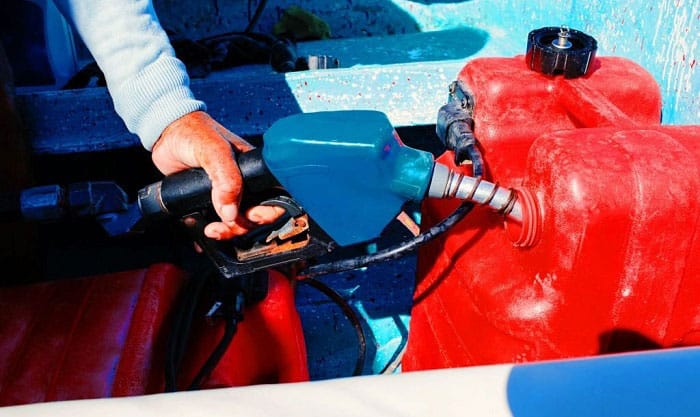
Boats have an average boat gas tank size of 40 gallons, but the range begins at around 5-10 GL for small boats, while yacht gas tank size allows up to 350,000 GL.
Let’s look at a few types of vessels and see how much fuel certain models of 20 ft boat hold.
- The SunDeck Sport 201 IO Hurricane deck boat gas tank size allows for 47 GL, while the MasterCraft 2023 ProStar ski boat carries only 30 GL.
- Even watercraft belonging to the same category may differ significantly in their capacity. A center console boat like the Yamaha 195 FSH Sport maxes out at 40 GL, while Bayliner’s T20CC and T20CX both top out at 55GL.
- Bass boat gas tanks usually range between a 25 to 50 GAL For instance, the Skeeter ZX200 has a gas capacity of 36 GL.
- Pontoon boat gas tank size ranges from 20 to 35 GL. However, some Pontoon gas tank size can go as low as a mere 5 GL since these are typically for lounging and not actual boating.
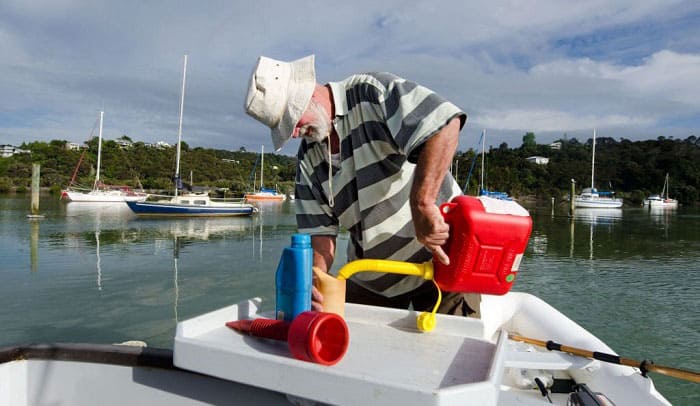
Why is it important to know your boat’s gas tank size?
The amount of fuel you have directly affects how long your vessel can operate, and knowing the tank size means maximizing its potential. This requires you to learn how to know the size, find the exact figure, and plan your activity well to make the most of any craft.
What are the types of gas tanks?
The two basic types of gas tanks are permanent and portable.
- Portable ones are those that can be disconnected and even swapped out. However, these usually have a lower capacity—around 5 GL.
- Permanent are those fixed to a spot on the boat, usually on or below deck, and can hold 10 GL and up. It is common for larger vessels to have multiple of these.
How do you calculate the size of a boat’s gas tank?
Aside from running your boat fuel tank’s dimensions through a boat fuel tank size calculator, you can make the calculations yourself. For example, the formula for calculating the volume of a rectangular tank is multiplying its length, width, and height.
This yields your tank’s volume in cubic feet. Convert it to gallons for the standard unit of measurement used in measuring boat fuel capacity. Do so by multiplying the resulting volume by 7.48.
How do you check a gas tank on a boat?
Finding out your boat tank’s size by measuring it requires you to have full access to it. Portable tanks are easy to measure as you only need to disconnect them to take their dimensions. However, a fixed tank can be problematic.
If you can’t access enough of the tank to measure it, use the first method (filling an empty tank and calculating the volumes of fuel used) instead.
Now you know how to find out your boat gas tank size even without access to the owner’s manual. You’ll notice that the boat’s manual contains a lot of essential information, so keep it in a safe place and don’t lose it.
What other measurements or calculations do you know of that are necessary to make when the owner’s manual goes missing? Tell us your suggestions in the comments section below.
Remember to boat safely.

“My intention from the first day establishing Boating Basics Online is to provide as much help as possible for boaters who want to experience a first safe and convenient trip. So feel free to join us and share your beautiful journeys to the sea!”

IMAGES
VIDEO
COMMENTS
The price of filling a superyacht with fuel depends on various factors, such as the vessel's size and fuel tank capacity. An average 70-meter superyacht utilizing 500 liters of fuel an hour may have fuel costs around $400,000 a year, though these costs will increase significantly for larger vessels. 'Northern Sun' Superyacht (credit ...
On the other hand, larger and more luxurious yachts, like superyachts and mega yachts, boast significantly larger fuel tank capacities. Average yacht fuel capacity can vary anywhere from 10,000 to 50,000 gallons of fuel, allowing them to undertake extended journeys across vast distances with ease.
Average Fuel Capacity of a Superyacht. When it comes to the fuel capacity of a superyacht, the amount varies greatly depending on the size and type of the vessel. Generally speaking, a superyacht typically holds anywhere from 15,000 to 50,000 gallons of fuel. However, some larger vessels can hold upwards of 200,000 gallons.
That's Antibes to Miami with fuel to spare in the yacht's 23,757-gallon fuel tanks. The choice of using lightweight aluminum was also a major factor in increasing the yacht's efficiency.
3 hrs x 130 gph = 390 gallons. All that is left to do now is add up the total amount of fuel needed and multiply the number with the price per gallon. (7500+390) x $3,5 = $27615. In this example, the final cost of your will set you back a little bit more than 27 thousand dollars.
The size of the vessel and the yacht's fuel tank will be the biggest indicator of how far it can travel on one tank. However, the weather conditions and type of cruising will also be a factor. ... Regardless of the size of the mega yacht, there is a maximum allowance of 12 charter guests plus crew due to the SOLAS Convention (standing for ...
The majority of the time, older yachts consume much less fuel than newer ones, but they also don't travel as quickly. Yacht fuel capacities can vary from 1,000 liters to one million liters. Owners usually choose to have big tanks for fuel so they can travel longer distances, rather than having a smaller tank with extra guest space on board.
How much fuel does a superyacht need? Find out the answer and learn more about the world's largest superyacht on Yachting Pages, the ultimate resource for yachting enthusiasts.
Yachts are equipped with onboard fuel tanks responsible for storing fuel during voyages. The size of these tanks varies widely depending on the yacht's dimensions, intended use, and range requirements. Proper storage and maintenance of fuel tanks are essential to ensure the safety and efficiency of the vessel. Fuel Consumption and Efficiency.
Click to view the full table of specifications for Mega superyacht, including accommodation, performance, equipment and amenities. ... Fuel Capacity. 7000 Water Capacity. 1500 Equipment Generator - ... Thrusters - Amenities - Expand. Build Team. Yacht Builder CCN View profile . Naval Architect CCN View profile . Exterior Designer CCN View ...
TAGS: How to Top Story. A yacht's fuel system comprises everything from the boat's fuel tank to the engine's fuel injector or injectors. There are two distinct parts of the fuel system: that installed by the boatbuilder and that attached to the engine. The tank, primary filter and all the pipework to and from the engine are designed and ...
Fuel Capacity. 850000 Water Capacity. 175000 Equipment Generator - Stabilizers - Thrusters - Amenities - Expand. ... Yacht Builder Lurssen Yachts View profile . Naval Architect Lurssen Yachts View profile . Exterior Designer Espen Oeino View profile . Interior Designer Jonathan Quinn Barnett No profile available. Yacht Specs. Guests. 26; Speed.
The yacht was transferred from her original dock at Lurssen Shipyard, measuring 170m, to a larger dock, measuring 220m, in May 2012. ... Azzam superyacht has a gross tonnage capacity of approximately 14,000t and features a fuel tank with a capacity of one million litres. Its main salon measures 29m in length, with its beam measuring 18m. ...
Dilbar yacht is considered one of the largest yachts in the world in volume. It was record-breaking owing to its incredible technology and the sheer size and was launched by German shipyard Lürssen in 2016. The fourth-longest yacht in the world that can house a crew of a hundred people also flaunts a total fuel capacity of 1,000,049 liters.
Each yacht will consume fuel differently for a number of reasons. It could be the size and make of the engines. Or, how often the yacht is using generators. As well as the number of tenders and water sports toys on board that require fuel. For example, if the yacht is out at anchor and running on generators 90% of the time, the fuel consumption ...
On average, a boat can hold around 40 gallons of gas in its fuel tank. But the range can vary from as small as 5 gallons or less for a small boat to as big as 250,000 gallons or more for a big yacht. Yet, most brands allow buyers to customize the boat accordingly, worrying less about fuel volumes. Boats are not as fuel-efficient as cars.
retained most fuel and water tank capacities and their effect on trim and stability. class-leading fuel range at >7000miles @ 10kn. more potable water/ballast than you need to fill a small swimming pool. ample greywater, and blackwater capacity. a nifty, passive water/glycol cooling system suitable for high latitude operation, removing most ...
Fuel Capacity - Water Capacity - Equipment Generator - Stabilizers - Thrusters - Amenities - Expand. Build Team. Yacht Builder Lurssen Yachts View profile . Naval Architect Lurssen Yachts View profile . Exterior Designer Espen Oeino View profile . Interior Designers Mark Berryman No profile available. Yacht Specs. Guests. 22; Speed-Cabins. 11;
ST DAVID is a 60m luxury motor super yacht available for charter built in 2008, refitted in 2019. Charter up to 12 guests in 6 cabins (1 Master, 1 Double & 4 Twin) with a crew of 14. ... reaches a maximum speed of 17 knots with a range of up to 5,500 nautical miles from her 116,000 litre fuel tanks at 12 knots.
EXCELLENCE YACHT SPECS - 150ft / 45.7m luxury mega yacht was built by Richmond in 2010. View full specs & similar luxury yachts for sale. More search Featured yachts. About Us; Yacht Search; Charter a Yacht; ... Fuel Capacity : 2 x MTU: 16V 2000 M91-4,000: 18 knots Knots | MPH: Cruise Speed : 14 knots Knots | MPH: 3,500 nm:
Fuel Tank Capacity (in gallons) = Fuel Consumption Rate (in gallons per hour) × Maximum Travel Distance (in nautical miles) For example, if your boat's engine has a fuel consumption rate of 5 gallons per hour and you plan to travel up to 100 nautical miles, the fuel tank capacity calculation would be: Fuel Tank Capacity = 5 gallons/hour × ...
A 40-foot yacht with a 5,000-liter fuel tank can travel up to 3,000 nautical miles. Think of it this way: the bigger the boat, the bigger the fuel compartment. The bigger the fuel tank (for the size of the boat,) the farther it can travel. Other variables can affect those numbers, but these are the main factors you need to consider.
Boats have an average boat gas tank size of 40 gallons, but the range begins at around 5-10 GL for small boats, while yacht gas tank size allows up to 350,000 GL. Let's look at a few types of vessels and see how much fuel certain models of 20 ft boat hold.